*Note: If you find the text on some of the images blurry or hard to read, right-clicking the image and then selecting “open image in new tab” may improve the issue.
Policy Concerns
- Funding needs for mental health services post-COVID-19, to assist students dealing with trauma, anxiety, and stress related to the pandemic and its aftermath.
- Addressing the need for more recovery-oriented educational supports, such as schoolwide positive behavioral interventions and support, in addition to classroom-based social and emotional learning
- Addressing the disproportionate amount of exclusionary disciplinary measures for students receiving special education services and students of color.
- Addressing the disproportionate use of corporal punishment on students with disabilities or special needs.
- Lack of trauma-informed care training among teachers and other school personnel.
- As a result of the 86th legislative session, there is no longer a limit on the number of school marshals per student ratio.
- Monitoring threat assessment team outcomes, as other states have disproportionate assessments completed for students of color and students with disabilities.
- Ensuring appropriate resources and supports for teachers and staff to promote and support their mental health and well-being.
- Inadequate funding prioritized for mental health professionals in schools, leading to a severe gap in professional-to-student ratios across the state.
- Providing a definition of school social work services to the Texas Education Code.
- Lack of transparency in statewide discipline data.
- Lack of knowledge surrounding students’ classroom removals due to the disproportionality of classroom removals coded as a violation of local code of conduct.
- School districts’ inability to enroll as a Medicaid provider to receive reimbursement for and provide mental health services to any student who is a Medicaid recipient. Currently, only schools enrolled in the School Health and Related Services (SHARS) program are able to bill Medicaid for certain services only for children receiving special education services.
- Ensuring provisions and policies related to school safety are not disproportionately impacting students with disabilities and students of color.
- Address current policies that allow foster care and youth experiencing homelessness who may be struggling with substance use to be removed from the classroom and given out of school suspension or an expulsion without other interventions or supports.
- Ensuring the revision of the health TEKS curriculum adequately educates students on mental health, substance use, suicide prevention, and overall well-being and wellness.
- Increasing state funding for Communities in Schools, which is yet to implemented across the entire state.
Fast Facts
- According to Texas Education Agency’s (TEA) Texas Academic Performance Report, 10.8 percent of school-aged children were enrolled in special education services in 2018-19.
- In 2017-18, the number of students experiencing homelessness rose substantially, as over 46,000 of the students identified as homeless were affected by hurricanes that year. In 2018-19, 1.3 percent of students were identified as homeless, the same percentage reported in 2016-17.
- The COVID-19 pandemic is expected to impact rates of evictions as families face prolonged unemployment and economic hardships, placing more families and children at risk of homelessness.
- Between 2008-09 and 2018-19, the percentage increase in the number of students identified as economically disadvantaged (22.5 percent) was greater than the percentage increase in the student population overall (14.4 percent).
- Roughly 31 percent of students eligible for special education services in 2019-20 had a primary diagnosis of a learning disability, 14 percent had a primary diagnosis of autism, and 6 percent had a primary diagnosis of emotional disturbance.
- In the 2018-19 school year, students enrolled in special education services represented 16.9 percent of expulsions to Juvenile Justice Alternative Education programs (JJAEPs), 17.6 percent of expulsions to Disciplinary Alternative Education programs (DAEPs) and 20.7 percent of out of school suspensions.
- The majority of expulsions to DAEPs and juvenile JJAEPs continued to be discretionary in 2018-19 (i.e., expulsions that were not mandated by state law but instead involve local codes of conduct).
- The majority of students in Texas identify as Hispanic (52.6 percent) and many of those students in Texas—nearly one million—are still learning English as their secondary language.
- During the 2017 academic year, more than half of school districts in the state did not require health education as part of requirements for graduation.
- One in five Texas high school students report using a prescription drug that was not prescribed to them.
- One in eight Texas high school students reported attempting suicide in 2018, almost twice the national average.
- Texas teens are more likely than the national average to have been offered, sold, or given illegal drugs at school in the last year
- During the 2016-2017 school year, Texas schools had a student-to-school social worker ratio of 7,548:1, well above the recommended ratio of 400:1.
- During the 2016-2017 school year, Texas schools had a student-to-Licensed Specialist in School Psychology (LSSP) ratio of 2,890:1, well above the recommended ratio of 1,000:1.
- During the 2016-2017 school year, Texas schools had a student-to-school counselor ratio of 442:1, well above the recommended ratio of 250:1.
TEA Acronyms
- AEP – Alternative education program
- AISD – Austin Independent School District
- ARD – Admission, review and dismissal
- ASCA – American School Counselor Association
- CCIT – Children’s crisis intervention training
- CEU – Continuing education unit
- CIS – Communities in schools
- CIT – Crisis intervention teams
- COVID- 19 – Coronavirus disease of 2019
- DAEP – Disciplinary alternative education program
- DFPS – Department of Family and Protective Services
- DSHS – Department of State Health Services
- ESC – Education service center
- FAPE – Free appropriate public education
- HHSC – Health and Human Services Commission
- IDD – Intellectual and other developmental disabilities
- IDEA – Individuals with Disabilities Education Act
- IEP – Individual education plan
- ISD – Independent school district
- ISS – In-school suspension
- JJAEP – Juvenile justice alternative education program
- LEA – Local education agency
- LMHA – Local mental health authority
- LSSP – Licensed specialist in school psychology
- MFA – Mental health first aid
- NCEC – Non-categorical early childhood
- NCTSN – National Child Traumatic Stress Network
- OSEP – Office of Special Education Programs
- OSS – Out-of-school suspension
- PBIS – Positive behavior interventions and services
- PPCD – Preschool program for children with disabilities
- PTSD – Post-traumatic stress disorder
- RSC – Regional service centers
- SEL – Social and emotional learning
- SHAC – School health advisory committee
- SHARS – School Health and Related Services Program
- SSA – Shared service agreement
- SRO – School resource officer
- TBSI – Texas Behavior Support Initiative
- TIC – Trauma-informed care
Organizational Chart
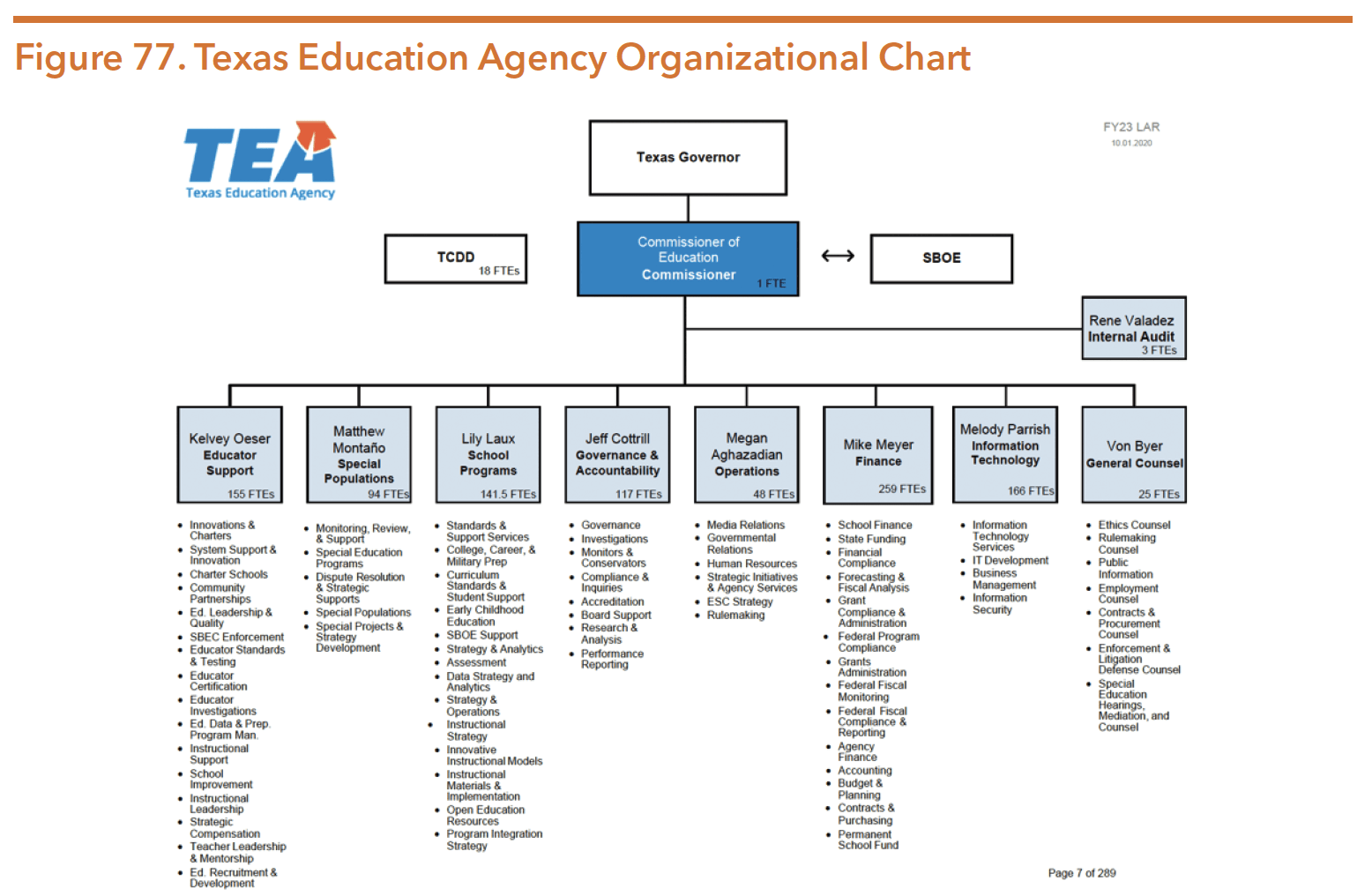
Source: Legislative Budget Board. (October 2020). Texas Education Agency, fiscal year 2022-2023 legislative appropriations request, October 2020 – volume 1 of 2.. Retrieved from http://docs.lbb.state.tx.us/display.aspx?DocType=LAR&agy=703&fy=2022
Overview
The Texas Education Agency (TEA) provides oversight and administrative functions for all primary and secondary public schools for the 1,201 school districts and 179 open-enrollment charter school campuses in the state of Texas.16 According to TEA, 5,431,910 students were enrolled in Texas public schools in the 2018-19 school year.17 Over a ten-year period, total enrollment in Texas schools increased by roughly 14.4 percent, or 682,339 students.
Unrecognized or poorly supported mental health conditions can negatively impact a child’s academic performance, classroom behavior, and school attendance. The most recently available data from the National Survey of Children’s Health (2018) reveals over 13 million children in Texas ages 3-17 years old had a mental, emotional, developmental, or behavioral need, however only 557,501 report receiving any support from a mental health professional.
In Texas, mental health supports and services may be provided in school settings by a number of trained professionals, including school counselors, nurses, school psychologists, and social workers. Despite the professional title, school counselors have many duties that are only tangentially related to mental health. Yet, according to Texas law, “the primary responsibility of a school counselor is to counsel students to fully develop each student’s academic, career, personal, and social abilities.” Although the American School Counselor Association recommends a ratio of 250 students per school counselor, the ratio in Texas is almost double that number: there were 442 students per counselor for the 2016-17 school year. However, there are additional, non-counselor personnel that can provide much needed support and services in schools. These mental health workers can play a crucial role in strengthening a positive school climate, and ensuring mental health concerns are addressed for both students and teachers. Mental health professionals can include licensed clinical social workers, licensed school psychologists, occupational therapists, and other mental health professionals such as art and music therapists. Texas also has a special credential for Licensed Specialists in School Psychology, yet only 3,522 LSSPs worked across all Texas public schools in 2019. Texas does not have an adequate mental health professional workforce within the school system for any of the aforementioned professionals.
Changing Environment
Funding and legislative initiatives reflected a major focus on how to best keep schools safe throughout the 86th session. For more detailed information on the legislation passed, the Hogg Foundation completed a policy brief detailing the legislative provisions focused on mental health, school safety, and school climate. The brief can be found at: https://hogg.utexas.edu/wp-content/uploads/2020/01/FINAL_86th-Lege_Policy-Brief_School-Climate.pdf
House Bill 18 (Price/Watson)
HB 18 is a comprehensive school mental health bill focused on providing resources, training, and education to students and school employees. This bill is aimed at improving the school climate, and adds mental health, trauma, and substance abuse education (inclusive of students with intellectual disabilities) to required staff development training for school counselors, teachers, and principals. HB 18 also adds mental health and more expansive substance use information to the health curriculum.
House Bill 19 (Price/Watson)
HB 19 requires each local mental health authority (LMHA) to employ a non-physician mental health professional to serve as a regional mental health and substance abuse resource to school districts located within the education service centers (ESC).
House Bill 65 (Johnson/West)
HB 65 requires school districts to include data on out-of-school suspensions in the reports they are mandated to submit to TEA.
House Bill 906 (Thompson/Powell)
HB 906 creates the Collaborative Task Force on Public School Mental Health Services to study and evaluate the impact of state-funded mental health services provided to students, their family/guardians, and school employees. The task force will also evaluate training provided to school employees.
House Bill 1387 (Hefner/Creighton)
HB 1387 removes the limitation of school marshal-to-student ratio.
House Bill 2184 (Allen/Huffman)
HB 2184 outlines requirements for school districts when a student transitions from an AEP, including a DAEP, JJAEP or other residential program or facility operated by TJJD or other governmental entity, to a traditional classroom. A personal transition plan must be included for the student.
Senate Bill 11 (Taylor/Bonnen)
SB 11 is a comprehensive bill that focuses on expanding mental health initiatives, strengthens safety and emergency protocols, and provides funding to districts to increase safety and security on campuses. SB 11 addresses a multitude of areas related to school safety and mental health including physical hardening and building standards, as well as mental health and other supportive initiatives. These include the creation of Safe and Supportive School Program and Teams, and the creation of the Texas Child Mental Health Care Consortium and other telehealth and telemedicine programs after Senate Bill 10 (Nelson) was amended onto SB 11 during the legislative process.
Senate Bill 2432 (Taylor/Sanford)
SB 2432 expands mandatory student removal to DAEPS to include harassment as defined by the Penal Code.
House Bill 3 (Huberty/Taylor) – School Funding
HB 3 is a comprehensive education bill that has many provisions and changes to the school finance system. The bill includes $11.6 billion measure to which $6.5 billion is dedicated to public education spending, and $5.1 billion is dedicated to lowering property taxes. TEA provided multiple resources to help understand the bill in its entirety that can be found at https://tea.texas.gov/about-tea/government-relations-and-legal/government-relations/house-bill-3.
A few highlights of the bill include:
- Requires full-day Pre-K
- Funds an optional 30-day, half-day summer program
- Increases resources for students living in low-income families and for whom English is a second language
- Increases funding for special education
- Basic Allotment (BA) increase
- Tied to the Minimum Salary Schedule (MSS)
- 30 percent of increase must go to salary increase:
- 75 percent of the 30 percent must go to classroom teachers (more for 5+ yrs experience), librarians, school counselors, and school nurses;
- 25 percent may be used to provide an increase for full-time employees (except administrators) as determined by school district;
- Districts will have to report to legislature on each salary increase by position and amount; and
- Cannot use new hires towards 30 percent requirement, funding is for pay increases for current full-time employees.
- 30 percent of increase must go to salary increase:
- Tied to the Minimum Salary Schedule (MSS)
COVID-19
The COVID-19 pandemic presented new and unexpected challenges for communities, and greatly impacted schools. TEA recognizes that “as a result of school closures and remote learning due to the COVID-19 pandemic, students have been at higher risk of exposure due to adverse childhood experiences and first hand exposure to the effects of pandemic.” These incredible challenges will continue and evolve throughout the current school year and likely beyond. In response to the pandemic, TEA worked on a number of activities focused on supporting the mental health and well-being of students, their families, teachers, and the overall school. Some of these activities include:
- TEA posted information on their COVID-19 web page on remote counseling, a statewide mental health resource list, Multi-Tiered Systems of Support (MTSS) interventions, and how to contact hard-to-reach students. This website can be found at https://tea.texas.gov/texas-schools/health-safety-discipline/covid/coronavirus-covid-19-support-and-guidance
- TEA created a series of six trauma-informed care videos for educators during school reopening. These videos can be found at https://www.texasprojectrestore.org/
- TEA issued a To the Administrator Addressed letter with updates on the Safe and Supportive School Program (SSSP) required by Texas Education Code Sec. 37.115 as amended by SB 11. As of October 2020, TEA was working on the rulemaking process on SSSP and trauma-informed care, with guidance expected by summer 2021.
- In July 2020, TEA staff conducted virtual “listening tours” with school districts and Education Service Centers (ESCs) with expertise in providing student support services and well-being supports in a MTSS, including Project Advancing Wellness and Resiliency in Education (AWARE) Texas. TEA reports that their staff will use this input to develop guidance for providing supports for students and school staff in the recovery from COVID-19.
- In July 2020, the Project AWARE interagency partners hosted virtual office hours twice a month for the ESCs to support the well-being of students and school staff in their regions during COVID-19. Many ESCs have likewise initiated Professional Learning Communities with school counselors and district leaders to share resources from the Texas Education Code Sec. 38.253 inventories, MTSS school mental health lessons provided by Project AWARE, and new resources to support staff and student well-being as additional resources are identified.
- TEA collaborated with ESCs to establish voluntary School Mental Health Teams at each ESC.
- In July 2020, TEA coordinated with a therapist who volunteered to provide Trauma Informed Care: Circle of Support for Schools virtual sessions that were attended by over 500 district and ESC staff. TEA reports they will continue their efforts to bring virtual training and technical assistance consultation to districts.
CORONAVIRUS AID, RELIEF, AND ECONOMIC SECURITY (CARES) ACT
According to the Office of Elementary & Seconday Education within the U.S. Department of Education, Congress set aside approximately $13.2 billion through the CARES Act for the Elementary and Secondary School Emergency Relief Fund (ESSER Fund). The funds are “emergency relief funds to address the impact that COVID-19 has had, and continues to have, on elementary and secondary schools across the Nation.” TEA calculated the entitlements following the statutory formula and guidance provided by USDE. The formula states that a local education agency (LEA) will receive the same proportionate share of the total ESSER formula grant as it received in proportion to the state’s Title I, Part A grant in 2019-2020. According to TEA, a minimum of 90 percent of the ESSER grant to TEA will be allocated to LEAs that received Title I, Part A funding in school year 2019-2020. Providing mental health support and services are allowable use of these funds. All allowable uses of the grant funding include:
1. LEA discretion for any purpose under:
- Elementary and Secondary Education Act (ESEA)
- Individuals with Disabilities Education Act (IDEA)
- Adult Education and Family Literacy Act (AEFLA)
- Perkins Career and Technical Education Act
- McKinney-Vento Homeless Education Act
2. Activities related to coordination of preparedness and response to improve coordinated responses among LEAs with state and local health departments and other relevant agencies to prevent, prepare for, and respond to coronavirus;
3. Provide principals and others school leaders with the resources necessary to address the needs of their individual schools;
4. Address the unique needs of low-income children or students, children with disabilities, English learners, racial and ethnic minorities, students experiencing homelessness, and students in foster care, including how outreach and service delivery will meet the needs of each population;
5. Developing and implementing procedures and systems to improve the preparedness and response efforts of LEAs;
6. Training and professional development of LEA staff on sanitation and minimizing the spread of infectious diseases;
7. Purchasing supplies to sanitize and clean facilities operated by the LEA;
8. Planning for and coordinating during long term closures, including for how to provide meals to eligible students, how to provide technology for on line learning to all students, how to provide guidance for carrying out requirements under IDEA, and how to ensure other educational service can continue to be provided consistent with all federal, state, and local requirements;
9. Purchasing educational technology (including hardware, software, and connectivity) for students who are served by the local educational agency that aids in regular and substantive educational interaction between students and their classroom instructors, including low-income students and students with disabilities, which may include assistive technology or adaptive equipment;
10. Providing mental health services and supports;
11. Planning and implementing activities related to summer learning and supplemental afterschool programs, including providing classroom instruction or online learning during the summer months and addressing the needs of low-income students, students with disabilities, English learners, migrant students, students experiencing homelessness, and children in foster care; and
12. Other activities that are necessary to maintain the operation of and continuity of services in LEAs and continuing to employ existing staff.
Funding

Source: Legislative Budget Board. (October 2020). Texas Education Agency, fiscal year 2022-2023 legislative appropriations request, October 2020 – volume 1 of 2. Retrieved from http://docs.lbb.state.tx.us/display.aspx?DocType=LAR&agy=703&fy=2022
The total requested TEA budget for FY 2022-23 is $64,508,481,207. If included in the budget, the Exceptional Items Requests would add an additional $25,711,500.
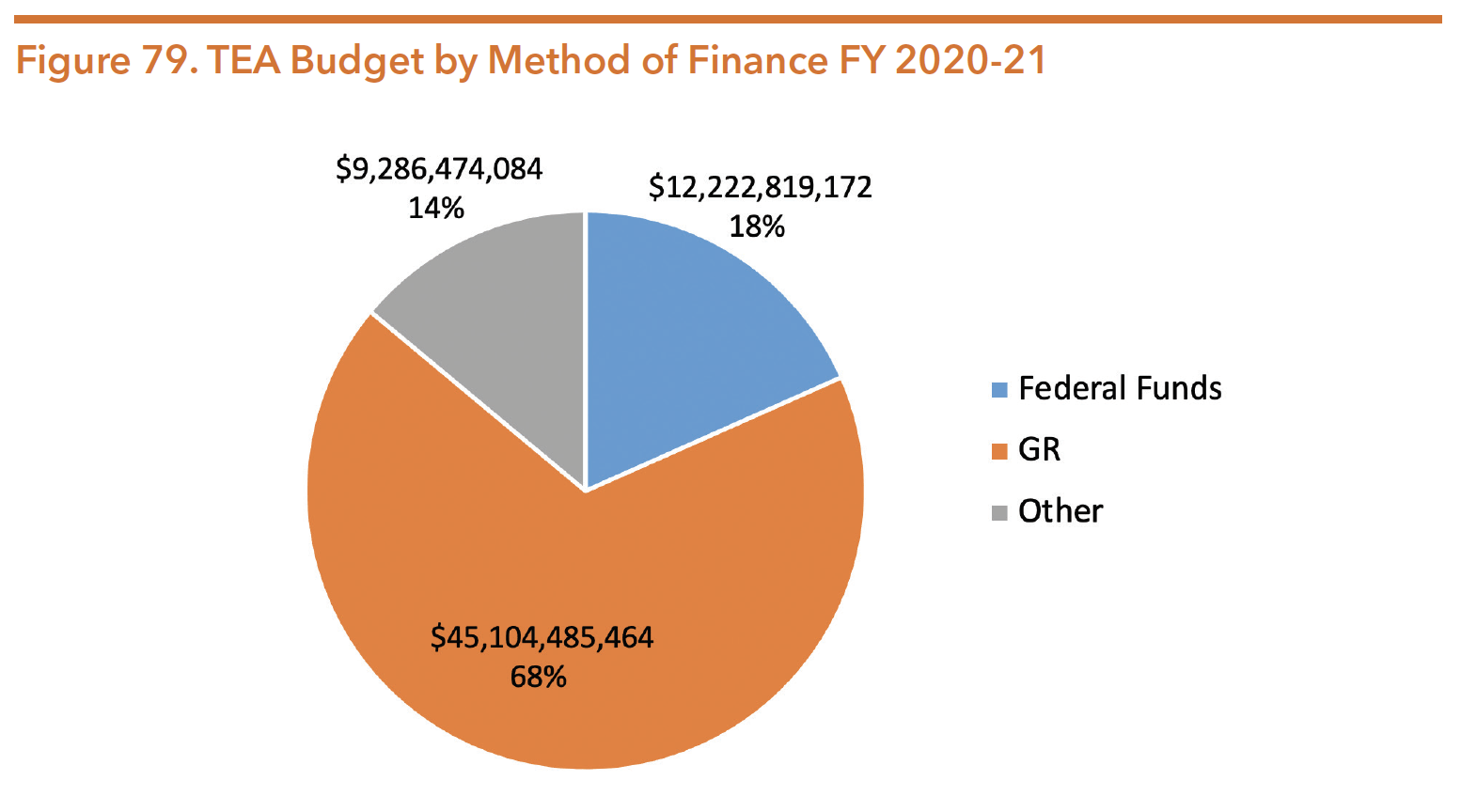
Source: Legislative Budget Board. (October 2020). Texas Education Agency, fiscal year 2022-2023 legislative appropriations request, October 2020 – volume 1 of 2. Retrieved from http://docs.lbb.state.tx.us/display.aspx?DocType=LAR&agy=703&fy=2022
The total TEA budget for FY 2020-21 was $55,838,888,685.
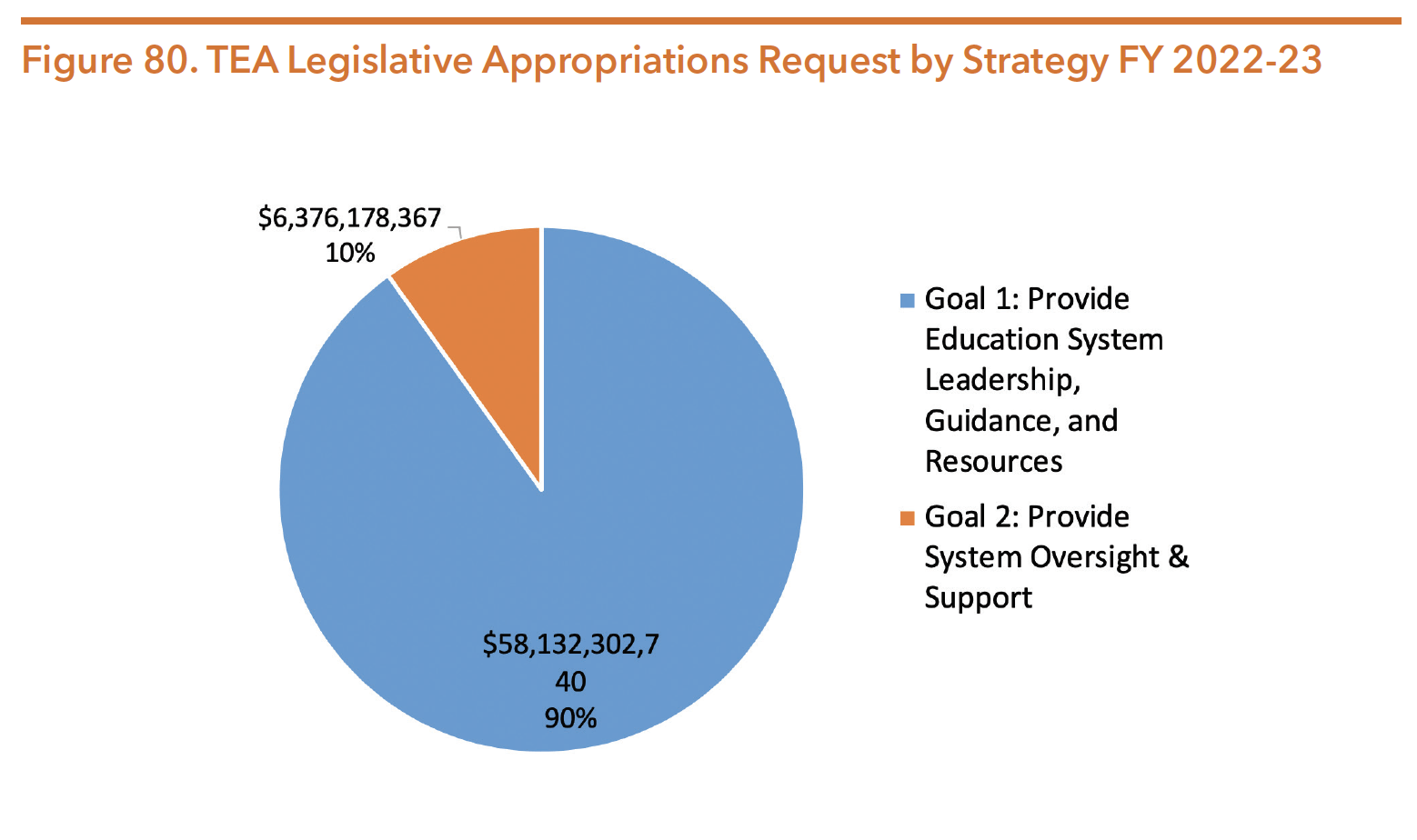
Source: Legislative Budget Board. (October 2020). Texas Education Agency, fiscal year 2022-2023 legislative appropriations request, October 2020 – volume 1 of 2. Retrieved from http://docs.lbb.state.tx.us/display.aspx?DocType=LAR&agy=703&fy=2022
INDIVIDUALS WITH DISABILITIES EDUCATION ACT
Under the Individuals with Disabilities Education Act (IDEA), children and adolescents between the ages of 3 and 21 who have disabilities are entitled to receive a free and appropriate public education.30 IDEA first passed in 1975 (as the Education for All Handicapped Children Act, PL 94-142) and has been reauthorized multiple times. In its current form, the IDEA both authorizes federal funding for special education and related services andsets out principles under which special education and related services are to be provided for states that accept the funds.
IDEA consists of four parts:
1. Part A contains the general provisions, including the purposes of the act and definitions.
2. Part B contains provisions relating to the education of school-aged children (the grants-to-states program) and the state grants program for preschool children with disabilities (Section 619).
3. Part C authorizes state grants for programs serving infants and toddlers with disabilities.
4. Part D contains the requirements for various national activities designed to improve the education of children with disabilities.
Part B is the largest part of the IDEA (nearly 95 percent of the Acts’ total funding in FY 19). IDEA Part B authorizes the state grant program and stipulates the conditions for receiving funds. States are required to educate students with disabilities in the least restrictive environment, which means with their peers in a normal classroom, to the extent possible. States are also required to provide a free, appropriate public education to all disabled students, which:
- Is provided at public expense, under public supervision and direction, and without charge;
- Meets the standards of the state education agency;
- Includes an appropriate preschool, elementary school, or secondary school in the state; and
- Is provided in conformity with the Individual Education Program established for the child.
The amount required to provide the maximum amount for each state’s grant is commonly referred to as “full funding” of the IDEA. When IDEA was created, Congress’ intention was that (1) states would provide every eligible child a free appropriate public education (FAPE) in the least restrictive environment, and (2) states would not take on an untenable financial burden by agreeing to provide special education and related services. At that time, the expected cost of educating students with special needs was projected to be twice as much as the national average of educating students who do not require special education services. To support schools with increased costs, the federal government committed to contributing up to 40 percent of this anticipated additional cost. Despite this commitment, the federal government has given less than half of its committed financial support since IDEA’s first year of funding in 1981.
Overall, spending for special education programs has increased since the inception of IDEA and its predecessor, but federal and state funding for special education has not increased proportionately. Local funding must make up the difference in funding for this increased need in order to meet IDEA’s requirements for providing special education services in schools. As Figure 81 shows, federal funding for special education through IDEA has remained relatively constant for the past 14 years and it is expected to remain constant despite an increase in the number of students eligible to receive special education. The federal trend of under-funding special education resulted in IDEA falling more than $10 billion short of being fully funded in FY 2014. The federal FY 2020 budget provides $13.8 billion in funding for IDEA, up from $13.47 billion in FY 2019.
Excluding funding for preschools through IDEA, TEA received $1,975,477,627 in federal IDEA Part B funding for the 2020-21 biennium, resulting in a decrease of approximately three percent from the 2018-19 biennium ($2,030,489,139).41 For the 2022-23 biennium, the funding is expected to remain mostly unchanged at $1,982,750,442.
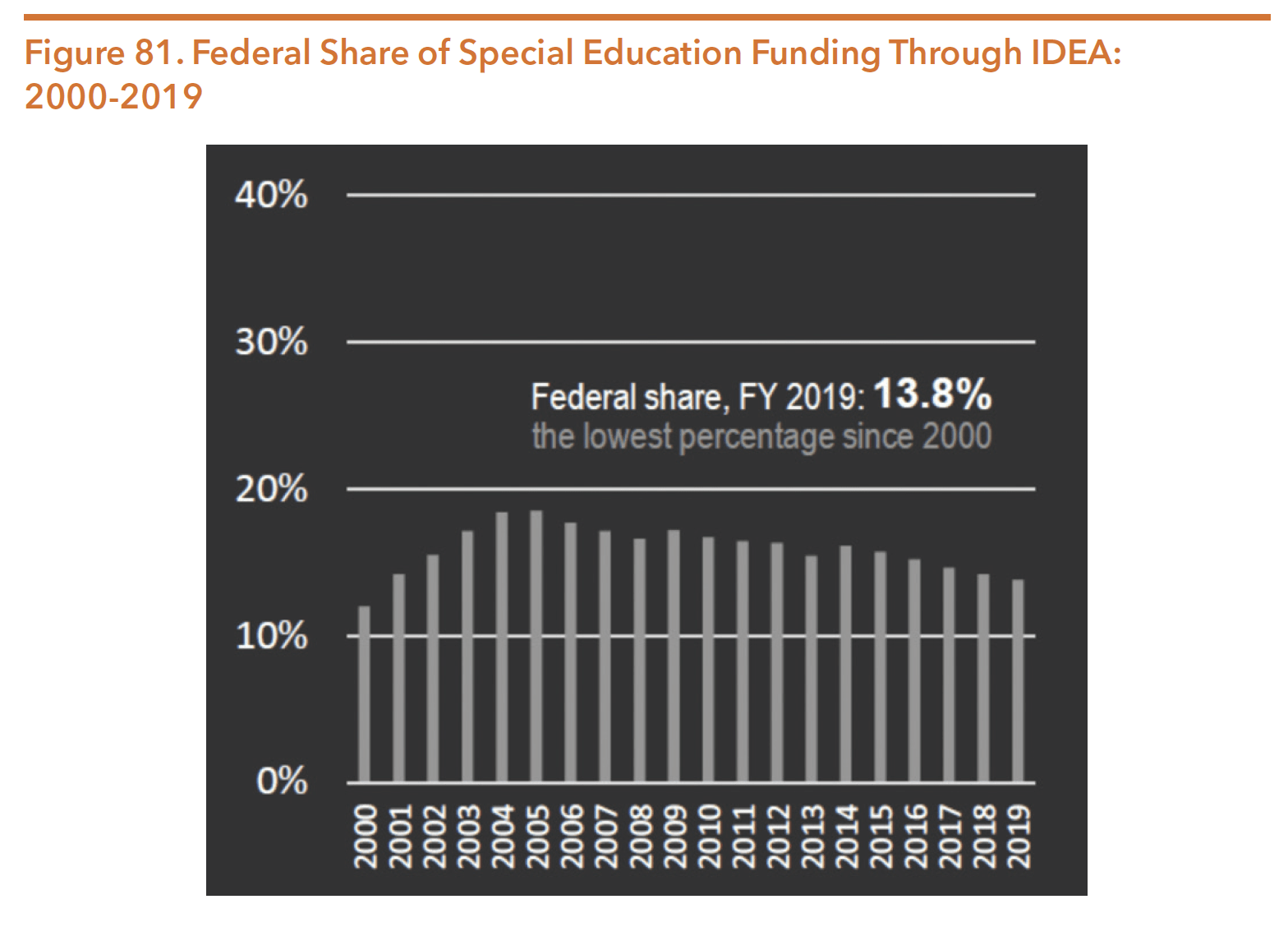
Source: The Advocacy Institute. (December 17, 2019). IDEA Money Watch. Retrieved from http://ideamoneywatch.com/balancesheet/?p=851
MEDICAID
In addition to funding from the federal and state government through IDEA, schools can bill Medicaid directly for certain eligible services through the School Health and Related Services (SHARS) program. Services provided by SHARS are made available through the coordination of TEA and HHSC. SHARS is a Medicaid financing program that allows local school districts and shared services arrangements to obtain Medicaid reimbursement for certain health-related services provided to students in special education. The state match requirement for SHARS Medicaid funding is met by using state and local special education allocations that already exist. School districts and shared service agreements (SSAs) must enroll as Medicaid providers and employ or contract with qualified professionals to provide these services.
Services covered by SHARS include:
- Audiology services
- Counseling
- Nursing services
- Occupational therapy
- Personal care services
- Physical therapy
- Physician services
- Psychological services, including assessments
- Speech therapy
- Transportation in a school setting
In order to receive SHARS services, students must meet all of the following requirements:
- Be 20 years of age or younger;
- Have a disability or chronic medical condition;
- Be eligible for Medicaid;
- Be enrolled in a public school’s special education program;
- Meet eligibility requirements for special education described in IDEA; and
- Have an individualized education program that identifies the needed services.
Delivery of Mental Health Services in Schools
For some youth, schools often serve as the first point of intervention when services or supports are needed because the majority of a young person’s day is in an academic setting. For some students, it can be as simple as having someone to talk to. For students with more complex needs, child and adolescent disorders will often continue into adulthood without early intervention.48 Many children in our public schools, while not living with serious emotional disturbance or mental illness, may be experiencing trauma or struggling with their mental health and well-being. Last year, 37 percent of Texas high school students reported feeling sad or hopeless for a period of two weeks or longer that resulted in decreased usual activity.
When needed, students are 21 times more likely to visit a school-based mental health service than a community mental health center. According to the American Counseling Association, in order to adequately support kids and their mental well-being in schools, Texas would need to double the number of counselors, triple the number of licensed specialists in school psychology (LSSP), and increase social workers 19 times to reach national levels. The Texas Education Code does not currently define school social work services, one crucial first step to getting more social workers in school systems. There are benefits for increasing mental health professional ratios in schools. For the schools that did follow the recommended ratio for counselors of 250:1, there were lower disciplinary rates and absenteeism, and increased graduation rates.
Early intervention with mental health concerns supports academic achievement, increases healthy stress management skills, improves social and emotional functioning and peer interactions, and allows schools to intervene before there is significant psychological deterioration. Furthermore, young children who receive effective, age-appropriate mental health services are more likely to complete high school, have fewer contacts with law enforcement, and improve their ability to live independently and be productive.
School-based mental health services encompass a wide variety of different programs and approaches. Special attention must be paid to schools in rural areas of the sate. A Texas A&M University-Kingsville study on access to mental health services found that rural schools struggle to provide mental health services to students; nearly half of the counselors surveyed in the study said that less than 25 percent of their students received adequate counseling services. According to a separate Center for Disease Control report, the percentage of children with diagnosed mental health and developmental disorders is consistently higher in rural areas. In Texas, the suicide rate is roughly 15 percent higher in rural counties (less than 20,000 residents) than in metropolitan ones. Barriers to delivering mental health services lead to inconsistent mental health care from school to school but even though access to services and supports varies based on a school’s region (i.e., urban vs. rural), academic level, and student population, most schools offer some level of mental health screening, referral or services.
The different methods of delivering mental health services in schools are described in Table 55.
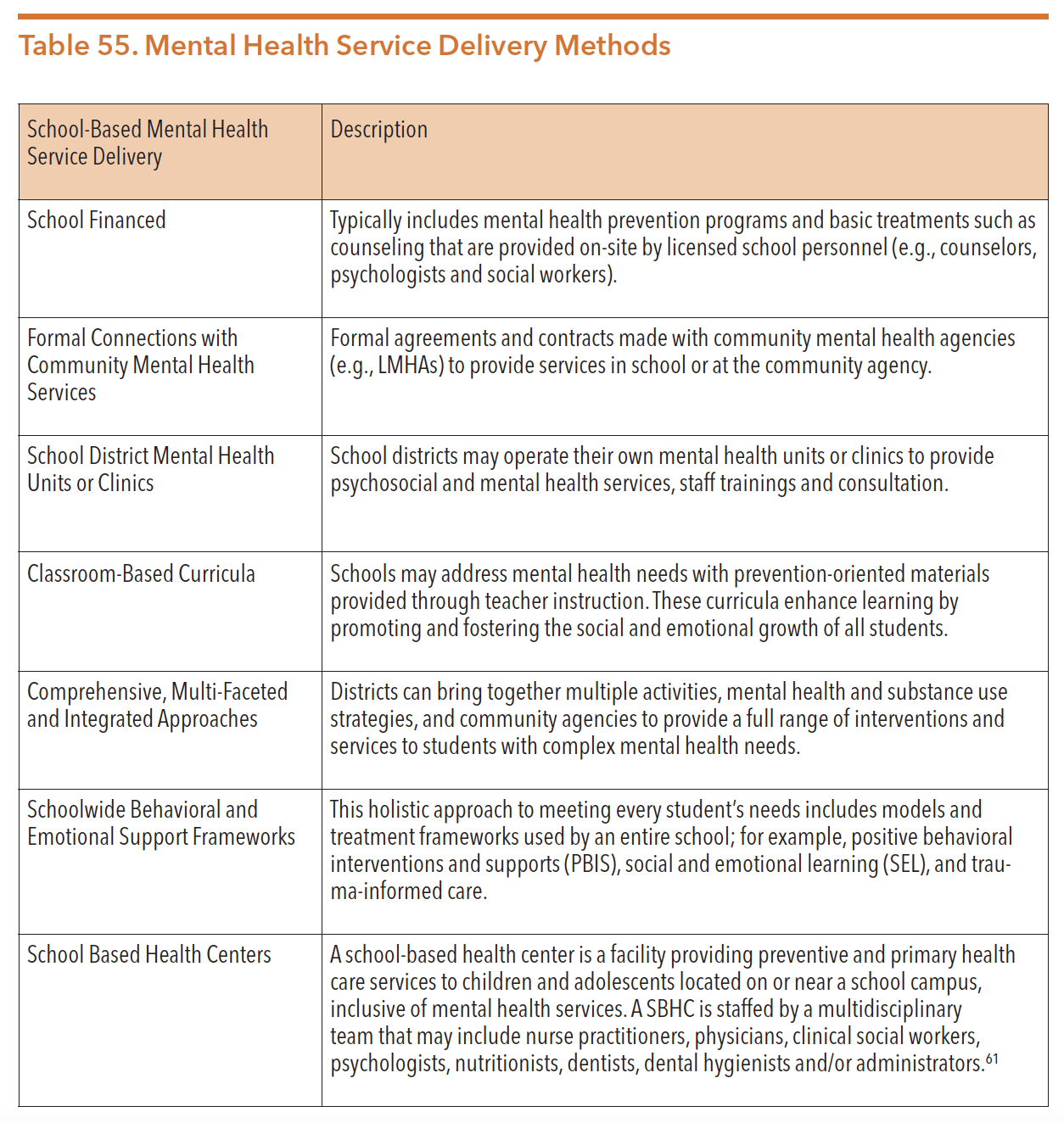
THE TEXAS CHILD HEALTH ACCESS THROUGH TELEHEALTH (TCHATT)
The Texas Child Health Access through Telehealth (TCHATT) Program is one component of the Texas Child Mental Health Care Consortium, established through SB 11 in the 86th Legislative Session. The Consortium is made up of 13 health-related institutions (HRI) of higher education. The legislation calls on the Consortium to “establish or expand telemedicine or telehealth programs for identifying and assessing behavioral health needs and providing access to mental health care services.” The TCHATT program will create or tap into existing telemedicine or telehealth programs to assist school districts with identifying student mental health care needs and accessing services, consisting of:
- Provision of direct psychiatry through telemedicine or counseling services through telehealth to children and adolescent within schools.
- Educational and training materials for school staff to assist in assessing, supporting, and referring children and adolescents with mental health needs for appropriate treatment and supports.
- Analysis and mapping of existing telemedicine and telehealth programs that are currently providing, or can be adapted to provide, services to schools.
- Statewide data management system that will track calls and responses in order to measure both need and responsiveness.
Each HRI may provide TCHATT services differently, but each will collaborate with schools to establish a process for referral. TCHATT services can last up to four sessions and can include assessment, therapy, psychiatric care, and referral assistance. Families will not be charged for services. As of September 2020, measures of the students seen in TCHATT, the types of services and referrals provided to students, and the outcomes of these services are being standardized. Additionally, the work of the Texas Child Mental Health Care Consortium considered the impact of COVID-19 and began adjusting the process for telehealth at families’ homes in addition to schools.
EDUCATION SERVICE CENTERS
Created in 1967, 20 regional educational service centers in Texas provide services, support, and technical assistance to all school districts throughout the state in a variety of areas, including special education and behavioral support. Enacted by the 75th Legislature, ESCs are required to assist school districts in improving student performance in each region of the state, enable school districts to operate more efficiently and economically, and implement initiatives assigned by the legislature or the commissioner. A map of service center regions is shown in Figure 82.
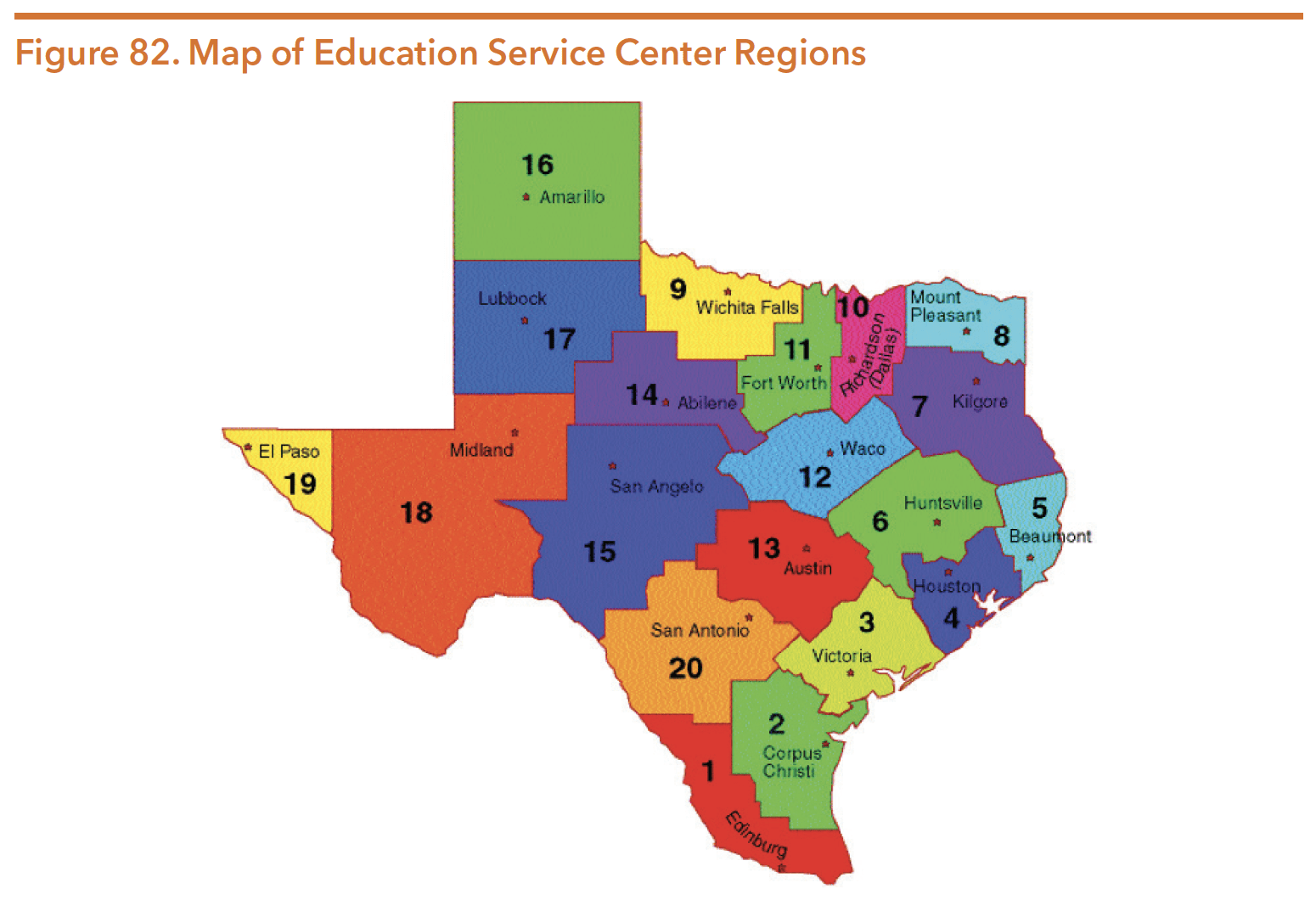
Source: Texas Education Agency. (2016). Education Service Centers Map. Retrieved from http://tea.texas.gov/regional_services/esc/.
ESCs specialize in specific topic areas and services, in addition to providing resources, support, programmatic assistance and general expertise to school districts or schools statewide. For example, the Region IV Education Service Center in Houston specializes in Positive Behavioral Interventions and Supports with the goal of enhancing the education experience for all students by addressing the needs of students with behavior challenges. Additionally, the Region XIII Education Service Center in Austin has a Behavior Team that includes general and special education specialists who focus on providing campuses with workshops, consultations, and technical assistance for behavioral supports. During the 86th legislative session, House Bill 19 (Price/Watson) passed requiring LMHAs to employ a non-physician mental health professional as a mental health and substance use resource for school districts. While not providing direct services, the professional will be located at the ESC as a resource for schools to:
- Increase school personnel awareness and understanding of mental health, substance use, and their co-occurrence, as well as resources available;
- Assist in implementation of programs and initiatives; and
- Facilitate optional monthly trainings.
A total of $23,750,000 was allocated to ESCs for Core Services in the 2020-21 biennium, with the same amount requested for the 2022-23 biennium. ESCs do not possess tax levying or bonding authority and rely on grants and contracts for funding. Revenues are received from three primary sources: state funds, federal funds, and contracts with school districts. The ESC infrastructure supports schools in complying with IDEA and, according to the required report from Rider 34, saved public and charter schools over $122 million during the 2016-2017 school year. These savings are a direct result of the products/services provided by ESCs to LEAs across Texas. Annual savings are mainly a result of school districts increased access to cheaper products and services through ESCs (as opposed to the open market or running those programs internally) and reduced transportation and staffing costs provided through distance learning opportunities (as opposed to in-person trainings). A total of 1,132,528 individuals were trained through ESCs in 2019, up from 949,616 trained in 2017. For 2022-23 TEA expects to continue training an estimated 885,000 individuals per year through the state’s 20 ESCs.
Special Education Services in Texas
Schools are accountable for the academic performance of all students, including those with disabilities such as serious emotional issues or mental health conditions. When academic performance is impacted due to a student’s disability, the Individuals with Disabilities Education Act (IDEA) requires schools to provide special education and related services based on an individualized educational plan (IEP). This may include mental health treatment and supports. One of the main purposes of IDEA is to ensure that children with disabilities have a free and appropriate public education (FAPE) that emphasizes special education and related services designed to meet their unique needs and prepare them for further education, employment, and independent living. Special education means specially designed instruction to meet the unique needs of a child with a disability. Related services are special services needed to support students’ special education services so they can make progress to meet their academic and functional goals. Related services can include services such as occupational therapy, physical therapy, speech/language therapy, counseling services, orientation and mobility services, and/or transportation services.
Special education services and supports provided are determined through an annual Admission, Review and Dismissal (ARD) meeting that typically includes the student, the student’s parents and/or caregivers, any mental health professionals involved in the child’s care, and school personnel including at least one of the child’s regular and special education instructors. The ARD meeting is an essential part of creating, updating, amending, and improving the individualized education plan on an ongoing basis. Students’ parents may request an ARD meeting any time they believe one is necessary. The IEP is the organizing framework and plan used to specify goals, supports,and interventions to help the student experience stability and success in the classroom. Schools are required by law to provide therapy services exactly as they are documented in the IEP. Schools cannot use personnel shortages, absences, or lack of funding to deny services. If the school fails to deliver services as documented in the IEP, the child may be eligible to receive “compensatory” services, including make-up services in the summer or private therapy paid for by the school.
Between 2004 and 2014, the population of Texas students receiving special education services decreased from 11.7 percent to 8.5 percent. The decrease in the proportion of students enrolled in special education services in Texas led to a Houston Chronicle series revealing an 8.5 percent benchmark implemented by the state in 2004 which subsequently led to a U.S. Department of Education investigation which concluded with directives for TEA to reform special education in Texas.
FEDERAL INVESTIGATION ON TEXAS’ SPECIAL EDUCATION SERVICES
For years, Texas was only identifying a very low percentage of school-age children as having special education needs, largely because of an 8.5 percent target implemented by TEA in 2004. An estimated 8.7 percent of school-aged children in Texas were identified as having special education needs in the 2015-16 school year. The percentage of children in Texas schools identified as eligible for special education services was far lower than in other states with the national average being about 13 percent.
In a 2016 series of articles in the Houston Chronicle, Texas was found to be limiting the number of students identified as eligible for special education services. The report by Brian Rosenthal alleged that TEA had systematically denied special education services to children across Texas by implementing an 8.5 percent target for children with disabilities served in school districts. The Chronicle disclosed that the benchmark was implemented in 2004, while TEA was facing a $1.1 billion state budget cut, and that it has effectively led to a denial of “vital supports to children with autism, attention deficit hyperactivity disorder, dyslexia, epilepsy, mental illnesses, speech impediments, traumatic brain injuries, even blindness and deafness.”
The Houston Chronicle report prompted a federal investigation by the U.S. Department of Education. In 2017, the Office of Special Education Programs (OSEP) within the U.S. Department of Education released a monitoring report that found three specific areas where TEA failed to comply with the federal Individuals with Disabilities Education Act:
1. TEA failed to ensure that all children with disabilities residing in the state who are in need of special education and related services were identified, located and evaluated, regardless of the severity of their disability, as required by IDEA.
2. TEA failed to ensure that a free appropriate public education was made available to all children with disabilities residing in the State in Texas’s mandated age ranges (ages 3 through 21), as required by IDEA.
3. TEA failed to fulfill its general supervisory and monitoring responsibilities as required by IDEA to ensure that independent school districts throughout the state properly implemented the IDEA’s child find and FAPE requirements.
Beginning in November of 2016, TEA began to address concerns expressed by OSEP. Actions included:
4. Issuing a letter to every independent school district in the state reiterating their “Child Find responsibilities” under the IDEA;
5. Coordinating a series of listening sessions throughout the state which were attended by both OSEP and TEA staff;
6. Governor Abbott, with the Texas Legislature, implemented SB 160 (85th, Rodriguez/Wu) prohibiting the use of school performance indicators to solely measure total number or percentage of enrolled children receiving special education and related services under the IDEA.
Following the full 15-month investigation, the U.S. Department of Education released their full report in January 2018. The investigation concluded that Texas failed to ensure students with disabilities were properly evaluated and that the state failed to provide an adequate public education for students with disabilities. According to The Texas Tribune, the report found that TEA was “more likely to monitor and intervene in school districts with higher rates of students in special education, creating a statewide system that incentivized denying services to eligible students” and that “school district officials said they expected they would receive less monitoring if they served 8.5 percent of students or fewer.” Further, school administrators delayed federally required evaluation of students suspected of having disabilities, often by providing intensive academic support. The report outlined corrective action for TEA to take including documentation of special education evaluation practices, developing a plan to evaluate previously denied students and directing educators on how to identify students with disabilities.
STRATEGIC PLAN FOR SPECIAL EDUCATION IN TEXAS
In 2018, TEA worked with various stakeholders across Texas to develop the Strategic Plan for Special Education in Texas. The plan lays out activities aimed at improving special education programs in Texas, including monitorting, training support and development, and student and family engagement. The majority of the strategic plan is funded through federal IDEA funding and state discretionary funds. This plan addresses the state’s role of monitoring and providing support and technical assistance to districts. There are no requirements for districts beyond what has been, and remains, a requirement of federal and/or state law.
The plan along with TEA’s progress in completing the activities in the plan can be found at https://tea.texas.gov/academics/special-student-populations/special-education.
ELIGIBILITY FOR SPECIAL EDUCATION SERVICES
Special education services encompass a wide range of interventions. Children can become eligible for these services by receiving a diagnosis for a specified condition or with general diagnosis of developmental delay, and as a result of the disability, need special education and related services to benefit from education. Figure 83 shows the various mental health diagnoses, behavioral conditions, and developmental disabilities that qualified 587,987 students in Texas for special education services in the 2019-20 school year.
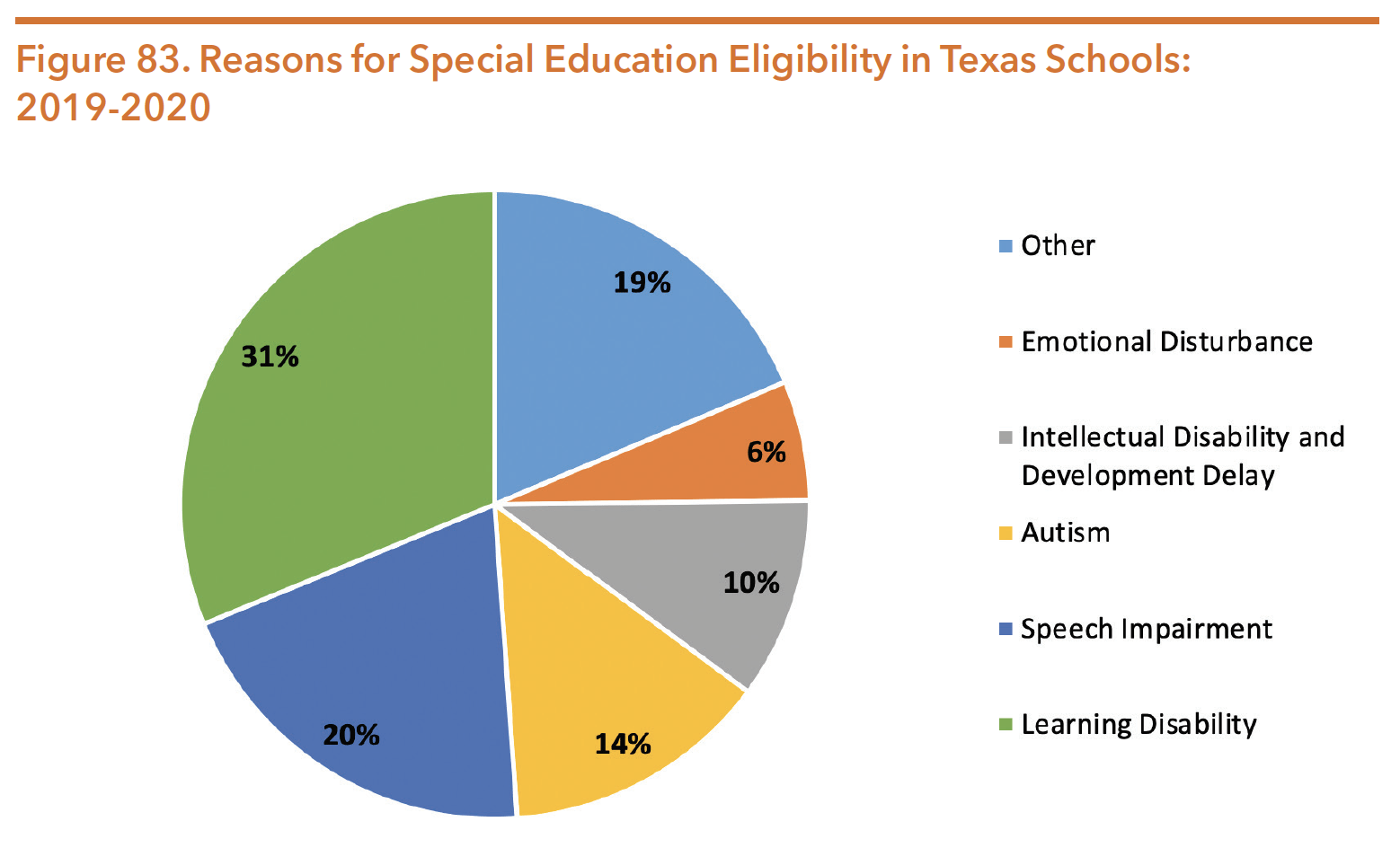
Note: “Other” includes Other Health Impairment, Auditory Impairment, Non-Categorical early childhood, Orthopedic impairment, Visual impairment, Deaf/blind and Traumatic Brain Injury.
Data obtained from: Texas Education Agency. (March 2020). 2019-2020 Special Education Reports: All Texas Public Schools Including Charter Schools, Students Receiving Special Education Services by Primary Disability, PEIMS Data 2019-20. Retrieved from https://rptsvr1.tea.texas.gov/adhocrpt/adser.html
During the 2019-20 school year, over 36,000 Texas students were identified as having serious emotional disturbance — roughly 6 percent of all students identified as eligible for special education services. Nationwide, students served under IDEA have a drop out rate of 21 percent, which students identified as having serious emotional disturbance have the highest drop-out rate (38.7 percent) among students receiving special education or general education. However, there are students who receive special education based on other primary disabilities (e.g., intellectual disabilities and autism) who also have mental health needs, such as depression, anxiety, post-traumatic stress disorder, attention deficit disorder, and more.
Eligibility for IDEA school-based mental health services for serious emotional disturbance is based on the student exhibiting one or more of the following characteristics to a marked degree over an extended period of time, in ways that adversely affect the student’s educational performance:
- An inability to learn that cannot be explained by intellectual, sensory, or health impairments
- An inability to relate appropriately to peers and teachers
- Inappropriate types of behaviors or feelings under normal circumstances
- A general mood of unhappiness and depression
- A tendency to develop physical symptoms, pains, or fears from personal or social problems
When determining whether special education services will be provided, school personnel seek evidence that the student’s behavior and need for services is not the result of a temporary reaction to adverse yet normal situations at home, in school, or in community situations. According to TEA, the number of students evaluated and served, as well as districts monitored and supported in order to serve these students has been a priority for the agency, illustrated in Figure 84 and Figure 85.
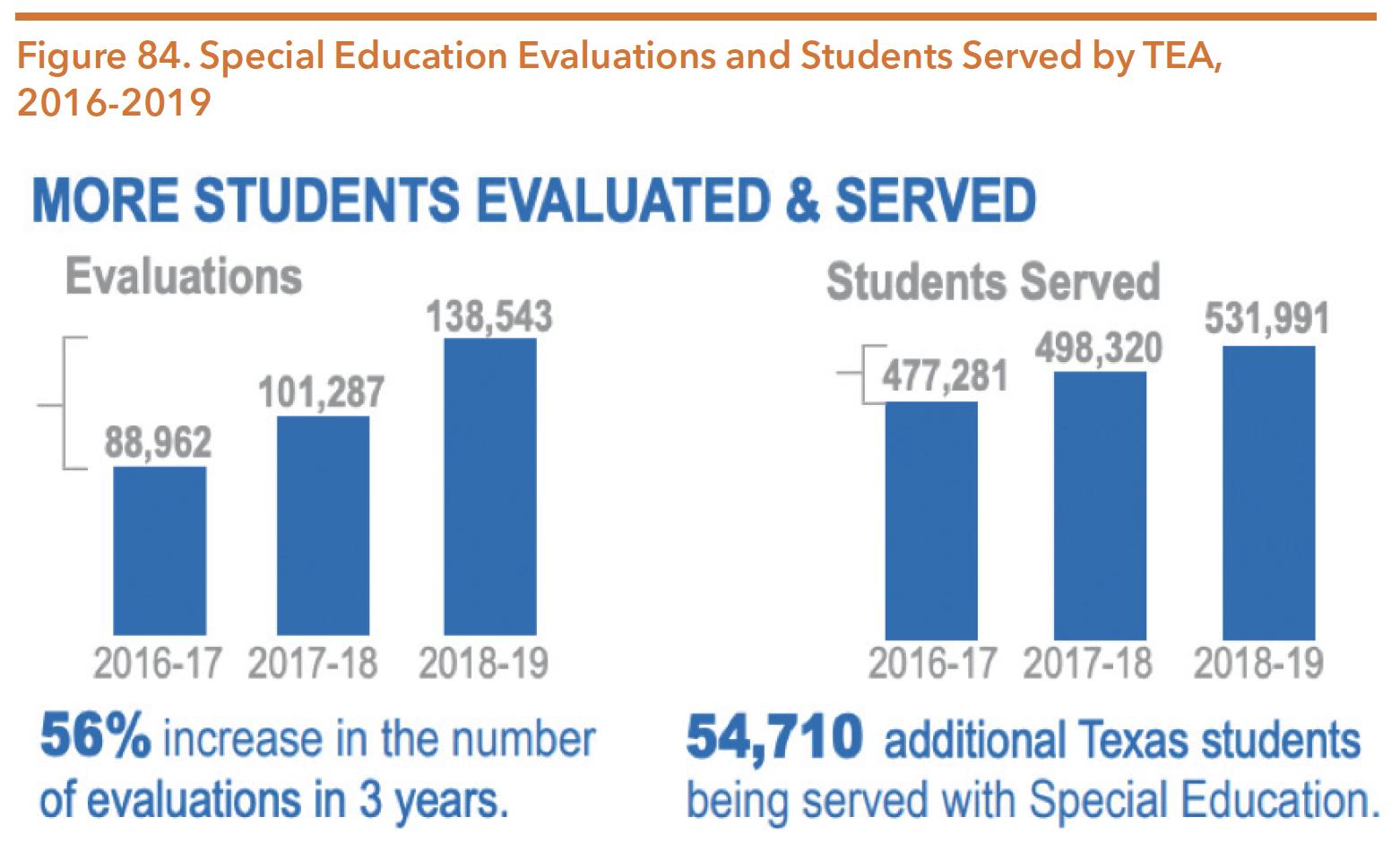
Source: Texas Education Agency. (2020). 2018-2019 Pocket Edition. Retrieved from https://tea.texas.gov/sites/default/files/2018-19%20Pocket_Edition_Final.pdf

Source: Texas Education Agency. (2020). 2018-2019 Pocket Edition. Retrieved from https://tea.texas.gov/sites/default/files/2018-19%20Pocket_Edition_Final.pdf
FUNDING FOR SPECIAL EDUCATION SERVICES
During the 2019-20 school year, roughly 7.1 million public school students received special education services across the U.S —over 14 percent of all students nationwide. During the same year, only 10.8 percent of the student population in Texas received special education services.
Funding for the “Students with Disabilities” strategy within TEA has gradually increased in recent years, with $2,108,308,102 budgeted for the 2016-17 biennium, $2,227,210,464 for the 2018-19 biennium, and $2,232,210,464 for the 2020-21 biennium. TEA has requested $2,163,495,650 for the 2022-2023 biennium, with federal funding accounting for 93.6 percent of the total requested funding.
SPECIAL EDUCATION FOR EARLY CHILDHOOD – DEVELOPMENTAL DELAYS
Because children’s brains are growing and their behaviors are constantly changing, it can be difficult to diagnose a young child with a psychological condition. There are also children without a mental health diagnosis who may still benefit from early intervention services. To bridge the gap for young children who do not have a specific diagnosis and may not receive services before entering school in kindergarten, IDEA allows for children between the ages of three and nine to qualify for special education services under a broader diagnostic category called “developmental delay,” as long as the diagnosis is made using proper instruments and procedures. The following types of diagnostic categories are designated as developmental delays at the federal level:
- Physical development
- Cognitive development
- Communication development
- Social or emotional development
- Adaptive development
States have the authority to decide what to call the “developmental delay” category, how to define it, and what ages to include as eligible. However states are not authorized to require a local education agency (LEA) to adopt or use the “developmental delay” term. Texas calls this developmental delay category “Non- Categorical Early Childhood (NCEC).” It includes children between the ages of three and five who have “general delays in their physical, cognitive, communication, social, emotional or adaptive development(s).”Because of delays, these children are in need of special education and related services. Children who fall under the NCEC category are provided services through a program called Preschool Program for Children with Disabilities (PPCD). PPCD services are provided at no-cost by the public school systems in a variety of settings such as pre-kindergarten, resource classrooms, self-contained classrooms, or community settings such as Head Start and pre-school. In addition to becoming eligible for PPCD services through the NCEC category, children in Texas may also qualify for PPCD under the following specific diagnoses:
- Intellectual disability;
- Emotional disturbance;
- Specific learning disability; and
- Autism.
EMERGING ADULTS
In recent years, Texas made efforts to bridge the gap in services and supports for students with special needs transitioning out of high school, known as “emerging adults”. To assist students who receive special education services with a successful transition from school to appropriate post-school activities, such as postsecondary and vocational education or integrated employment and independent living, schools must begin individual transition planning with students and their families by age 14. Schools are required to identify needed courses and related services for postsecondary education and to develop adult living objectives through each student’s IEP. The availability, comprehensiveness, and quality of transition services available in Texas vary widely across the state. Individual school districts, TEA, HHSC, and other state agencies make transition information available through a central website: www.transitionintexas.org.
The 85th Legislature passed HB 748 (Zaffirini/Allen) to update transition planning to reflect new state alternatives to guardianship. The bill updates the factors the ARD committee must consider regarding whether a student has sufficient exposure to supplementary services to help the student develop decision-making skills. The bill requires TEA to update the Texas Transition and Employment Guide with information about long-term services, community supports, and alternatives to guardianship. Additionally, the bill requires TEA to develop and post a list of services and public benefits available to an adult student.
Positive School Climate
Cultivating well-being at schools includes a wide array of school-wide practices that improve the school climate, including the availability of mental health services. According to TEA, a positive school climate “is the product of a school’s attention to fostering safety; promoting a supportive academic, disciplinary, and physical environment; and encouraging and maintaining respectful, trusting, and caring relationships throughout the school community no matter the setting.”
Additionally, utilizing trauma-informed education, positive behavior interventions and supports (PBIS), restorative discipline practices, and social emotional learning (SEL) so that all students and teachers are impacted positively, can create an overall supportive school community where students feel connected and safe. Providing a multi-tiered system of support through implementing strategies and supports that cultivate a positive school climate not only helps students and teachers feel safe and supported but also improves academic achievement.
Increasing mental health education, services, and supports in schools is an important component to improving school climate. Integration of mental health into schools can encourage normalizing discussions, discourage stigmatization, increase access to care, and provides opportunity for early identification and intervention, especially in rural schools where mental health resources in the community are more scarce.
Better integration has been shown to help increase recognition that mental health is a part of overall health rather than stand-alone items. By increasing knowledge, attitudes around mental health may improve, stigmatization may be assuaged, and the ability to recognize and appropriately respond to a mental health concern may be gained by students and educators. When students are socially, emotionally, and mentally well, they are able to better engage in their learning. Mental health initiatives and services are related to increased test scores, commitment to school, attendance, grades, and graduation rates, while also reducing truancy and disciplinary rates.
MENTAL HEALTH SUPPORT SYSTEMS FOR SCHOOLS
Mental health supports and services vary between individual schools and districts, often dependent on availability in the community or schools’ resources. Additionally, workforce issues and community or school leadership buy-in create additional obstacles for mental health professionals to be staffed within schools. For students being served through special education with individual education plans (IEPs), mental health services are required by law to be provided for students if those services are part of their IEP. Although the availability of mental health supports and services in school is not required, some schools have implemented programs and initiatives that support student mental health, as well as create a more broad, positive school climate. This next section describes the mental health supports, services, and related programs available statewide.
COORDINATED SCHOOL HEALTH MODEL
Texas school districts are required to provide a coordinated school health program by law that coordinates education and services related to physical health, mental health education, substance abuse education, phyiscal education and activity, and parental involvement. House Bill 18 (86th, Price/Watson) was responsible for expanding the coordinated school health programs to include mental health and substance use education.
TEA utilizes CDC’s Whole School, Whole Community, Whole Child (WSCC) framework for addressing health in schools. According to DSHS, “the WSCC model focuses its attention on the child, emphasizes a school-wide approach, and acknowledges learning, health, and the school as being a part and reflection of the local community.” The WSCC model Is an expansion and update of the Coordinated School Health Model, previously utilized by TEA. TEA is required to make one or more coordinated school health programs available to each school. The curriculum for the programs are directed by a mandatory, multidisciplinary team, known as the School Health Advisory Council (SHAC). SHAC members are appointed by the school district to serve and make recommendations for the district’s Coordinated School Health program.
The WSCC model includes the following components:
- Physical education and physical activity
- Nutrition environment and services
- Health education
- Social and emotional school climate
- Physical environment
- Health services
- Counseling, psychological and social services
- Employee wellness
- Community involvement
- Family engagement
HOLISTIC APPROACHES TO STUDENT WELL-BEING AND NEEDS
Addressing students’ needs in the classroom often extends beyond their learning. For a student experiencing trauma or other difficult life events such as family conflict or a natural disasater, learning can be difficult for them. When a child feels unsafe, frightened, or overwhelmed, their brain releases stress hormones, which places them in a state of “fight, flight, or freeze.” Typically, our brains and bodies subside and return to a a normal state. Unfortunately, this isn’t always the case when exposed to intense and stressful events or prolonged adversity, such as abuse, exposure to violence, parental substance use, or not having a safe and stable home. During this state, the brain prioritizes survival, so the events a child is currently experiencing, or has experienced in the past, interfere with thinking, learning, and behavior.114 Too often, unidentified mental health conditions or trauma are perceived as “bad” behavior, and punitive discipline practices are implemented. Exclusionary discipline practices have developmental, behavioral, academic, and high financial costs. The alternative models of intervention discussed in this section can support the social and emotional development of students and address their needs, while remaining more cost-effective than the resource-intensive exclusionary discipline practices (i.e., suspension and expulsion) that are often used in Texas public schools. This section will focus on five specific models and frameworks:
- Multi-Tiered Systems of Support
- Social and emotional learning
- Trauma-informed care
- Restorative justice (also known as restorative discipline)
Public schools in Texas are increasingly shifting their practices to be proactive, coordinated approaches to meet the behavioral and academic needs of all students. While some students with mental health needs require tailored interventions and trained professionals, there are also intervention models that provide a more holistic approach to supporting the needs of all students within a school system. These initiatives generally include campus-wide prevention activities, targeted early intervention for students identified to need support, and individualized services for students with complex needs. Texas is among a number of states promoting positive approaches to preventing mental and emotional problems in children.
Multi-Tiered Systems of Support
A Multi-Tiered System of Support (MTSS) is a data-driven, problem-solving framework to improve outcomes for all students. MTSS is not a curriculum, nor is it an intervention. It is simply a framework of how to identify and address school-wide needs in a way that is proactive and data-driven. MTSS relies on a continuum of evidence-based practices matched to student needs. According to TEA, MTSS encompasses supports for the whole child, and takes into account academics, behavior, and social/emotional supports. MTSS is also a research-based framework for the systemic alignment of initiatives, resources, staff development, prevention, intervention, services, and supports. Figure 86 illustrates MTSS what is encompassed within a MTSS. Figure 87 shows MTSS best practices.
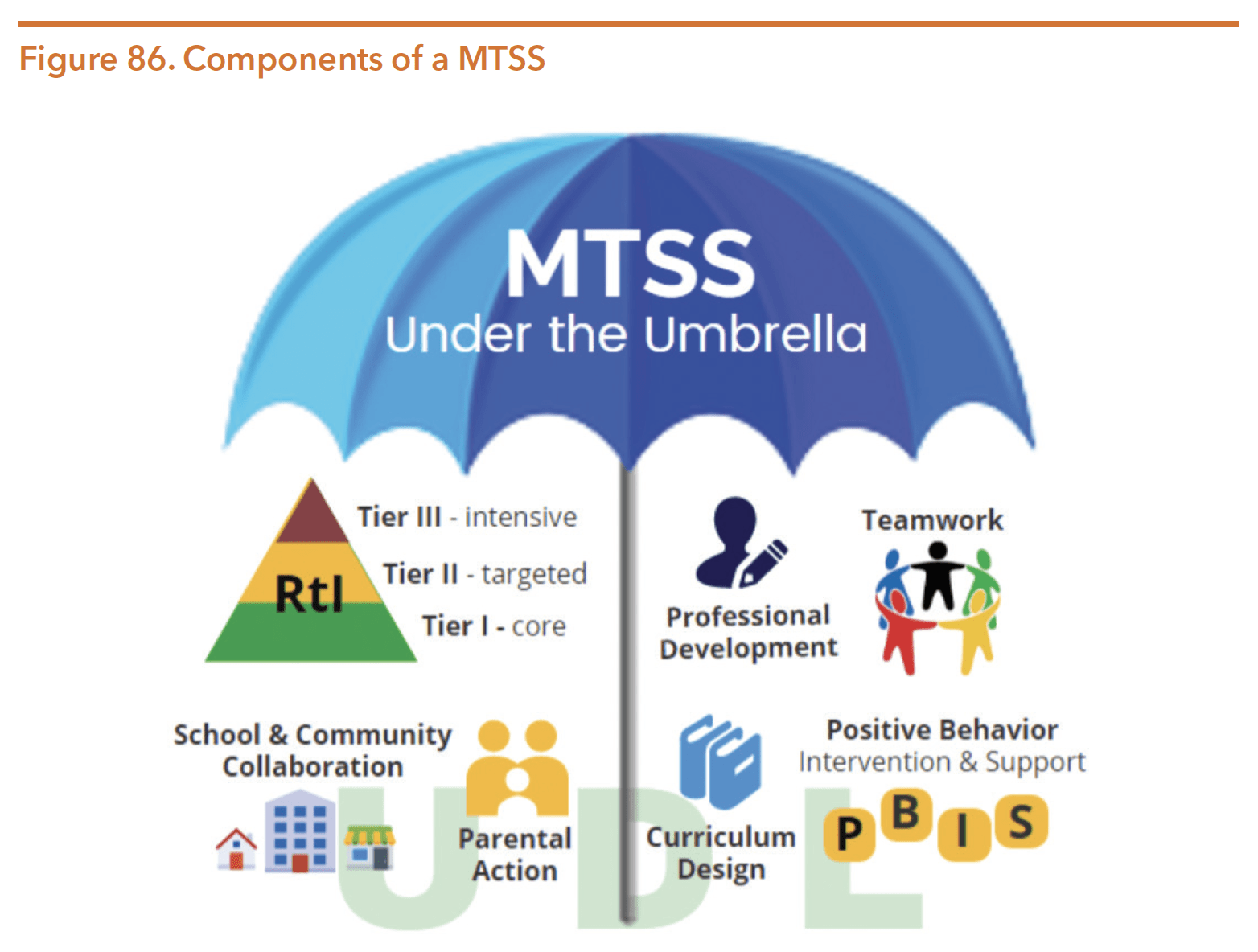
Source: University of Florida, Cedar Center. (n.d.) Muti-tiered system of support chapter. Retrieved from https://ceedar.education.ufl.edu/mtssudldi-professional-development-module/mtss-chapter/#toggle-id-7
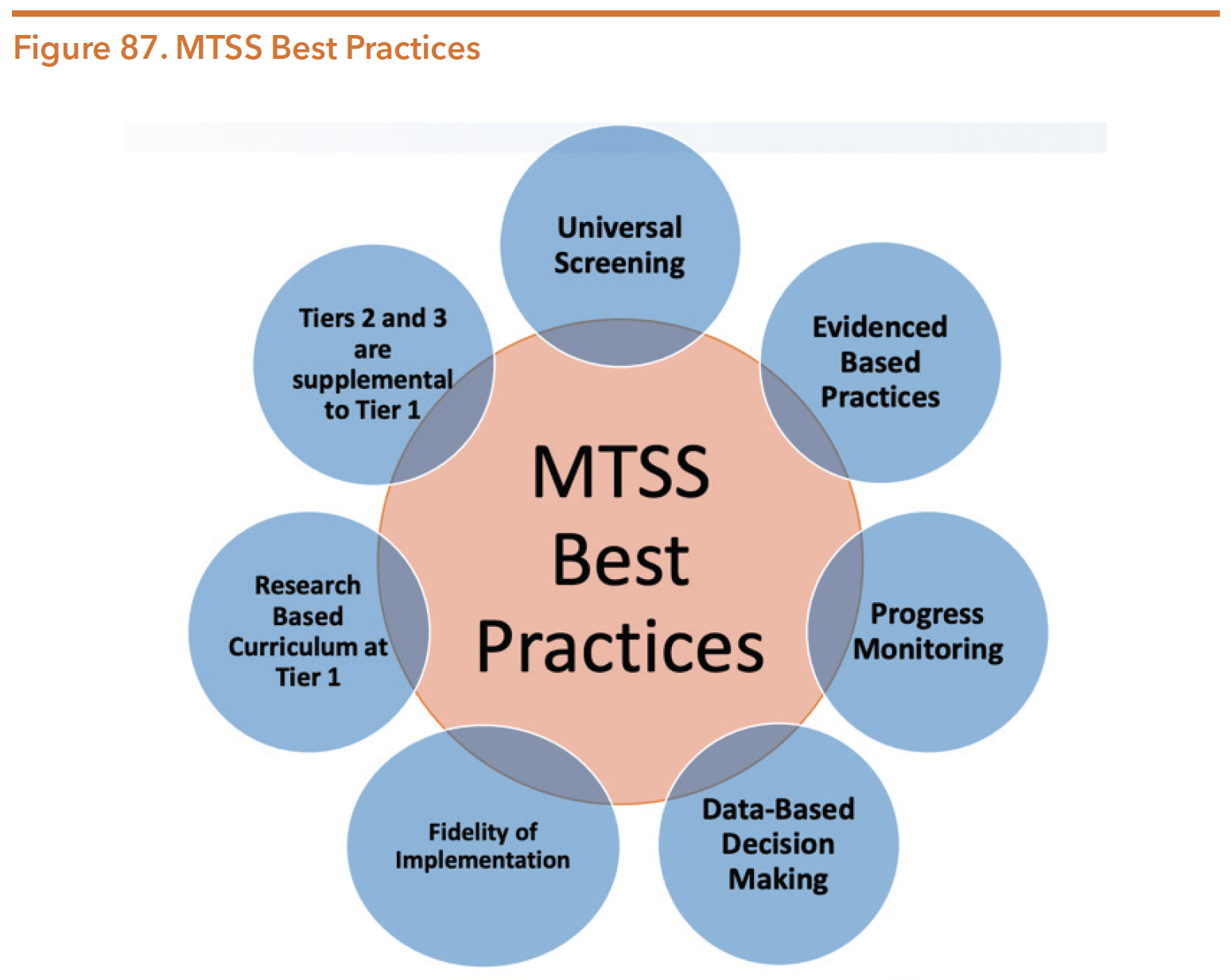
Source: Prater,S. Lee, C., Wilk, L., & Solano, F. (n.d.). Multi-Tiered Systems of Support (MTSS) questions and answers [PowerPoint]. Retrieved from https://tea.texas.gov/sites/default/files/TEA%20MTSS%20QA-Final_accessible%20PPT.pdf
Positive Behavioral Interventions and Supports
A well-known example of a tiered systems under the MTSS umbrella is positive behavioral interventions and supports (PBIS). Figure 88 illustrates the basic framework of PBIS. Figure 89 shows a more in-depth example of what types of services, interventions, and supports may be encompassed within each tier.
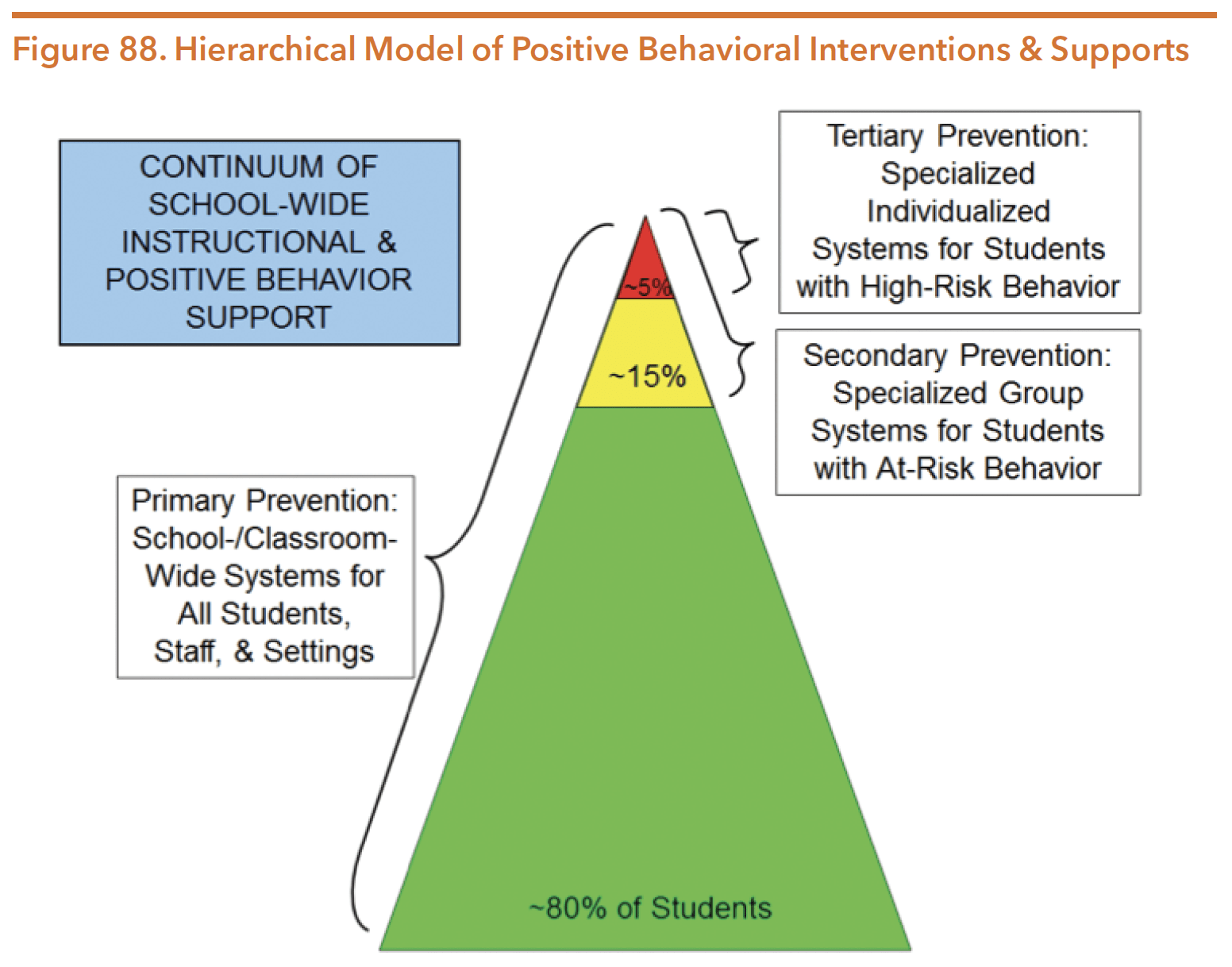
Source: U. S. Department of Education & Office of Special Education Programs’ Technical Assistance Center on Positive Behavioral Interventions and Supports. (2010). Implementation blueprint and self-assessment: Positive behavioral interventions and supports. Retrieved from https://www.pbis.org/Common/Cms/files/pbisresources/SWPBS_ImplementationBlueprint_vSep_23_2010.pdf

Source: Montery Pennsylvanis Unified School District. (2020). MTSS and PBIS. Retrieved from https://www.mpusd.net/apps/pages/index.jsp?uREC_ID=1012305&type=d&pREC_ID=1322797
PBIS is an evidence-based framework that uses a three-tiered approach to teach and reinforce appropriate behaviors for all students. PBIS programs are designed to replace a punishment-oriented system with a campus culture based on respect, open communication, and individual responsibility.
The program’s three tiers consist of the following:
- Tier 1: The primary prevention tier is the largest of the three, focusing on interventions for 80 to 90 percent of students. In this tier, school staff uses a curriculum to teach social skills and expectations that all students and school personnel are expected to follow.
- Tier 2: The secondary prevention level focuses on the 10 to 15 percent of students who have risk factors such as exposure to violence, a history of trauma, or the loss of a loved one that causes them to have a higher-than-normal risk of developing mental health needs. This tier focuses on developing skills and increasing protective factors for students and their families.
- Tier 3: The tertiary prevention level focuses on the 1 to 5 percent of the student population who need an in-depth system of supports. This tier is focused on providing comprehensive, individualized interventions for students with the most severe, complex or chronic issues.
TEA recommends that school districts utilize PBIS to address student behavior but public schools are not currently required to use PBIS or other related approaches. During the 85th legislative session, Texas passed three bills that were related to PBIS:
1. HB 4056 (Rose/Lucio) – requires the inclusion of PBIS on the state’s best practice list.
2. SB 179 (Menendez/Minjarez)- requires that if a district does develop any practices or procedures related to PBIS, it must include them in their student handbook and district improvement plans.
3. HB 674 (Johnson/Garcia)– allows schools to develop positive behavior programs for students in grade levels below grade three as a disciplinary alternative.
4. Continuing to improve integration of PBIS into Texas schools, the 86th Texas Legislature passed House Bill 18 (Price/Watson), which included a number of provisions inclusive of PBIS including:
- Allowing PBIS to be part of school staff development training;
- Requiring schools’ district improvement plans to include provisions for evidence-based practices that address PBIS and integrate best practices on trauma-informed care; and
- Requiring schools to develop practices and procedures concerning PBIS.
Technical assistance to implement PBIS is available through the network of regional educational service centers and the Texas Behavior Support Initiative (TBSI). TBSI was designed to build capacity throughout the state for the provision of positive behavioral interventions by assisting schools in developing and implementing a wide range of behavior strategies and prevention-based interventions.
Social and Emotional Learning
According to TEA, social and emotional learning (SEL) is not a specific program, but a framework that “involves the process of understanding and applying the knowledge, attitudes and skills necessary to understand and manage emotions, set and achieve goals, feel and show empathy for others, establish and maintain positive relationships and make responsible decisions.” Figure 90 illustrates the core competencies of SEL.
The main goals of the SEL framework are to:
- Help students work well and productively with others;
- Develop positive relationships;
- Cope with their emotions;
- Appropriately settle conflicts with consideration for others;
- Work more efficiently and effectively; and
- Make decisions that are safe, ethical, and responsible.
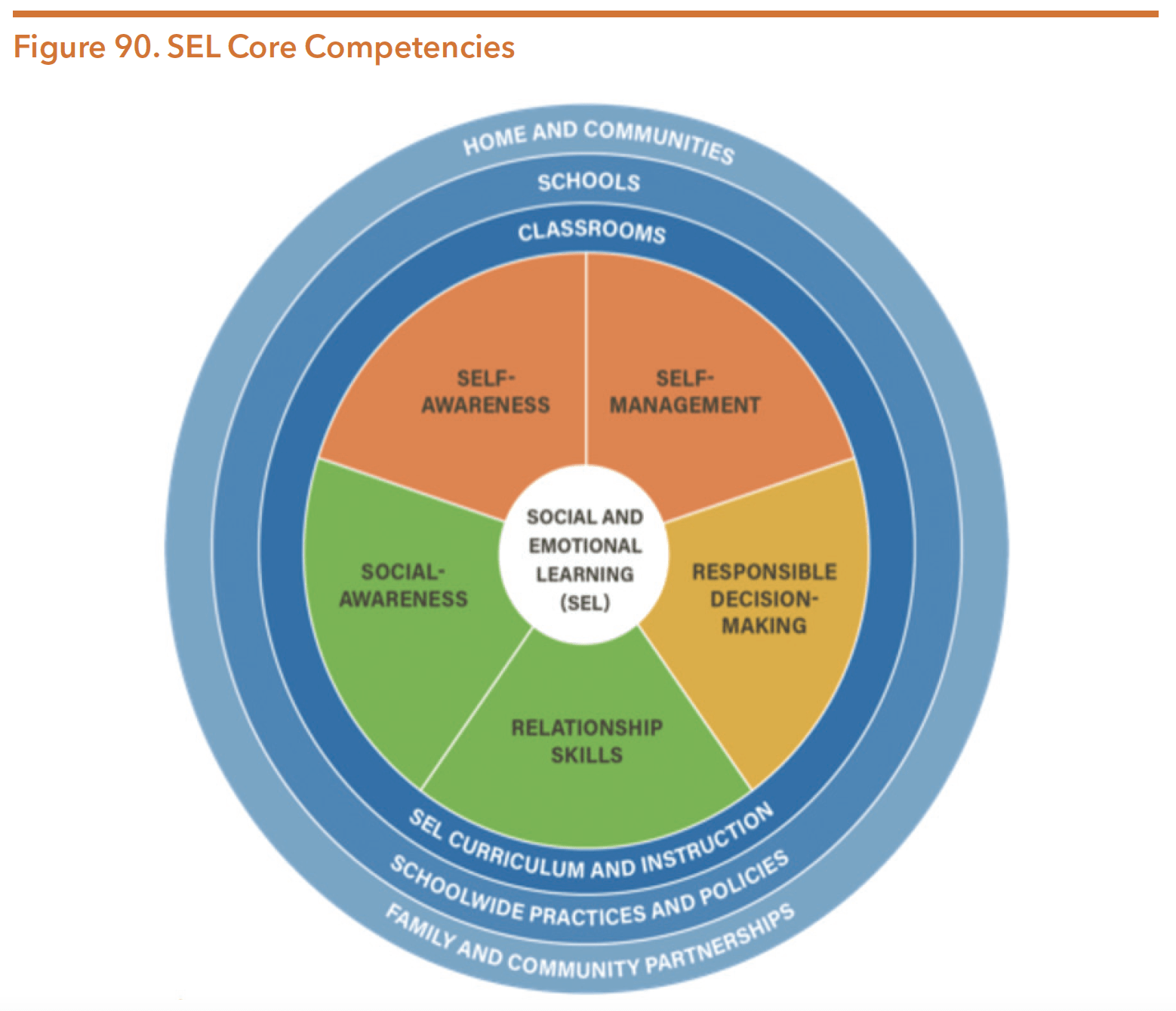
Source: Collaborative for Academic, Social, and Emotional Learning (CASEL).(n.d.). What is SEL? Retreived from https://casel.org/what-is-sel/
As a result of HB 18 (86th, Price/Watson), Texas schools are required to develop practices and procedures related to SEL, defined as “building student skills related to managing emotions, establishing and maintaining positive relationships, and responsible decision-making.” Schools can choose from a variety of proven, effective SEL programs, but it is not necessary to hire additional staff to implement SEL—the primary costs of an SEL program are related to staff training and student surveys. SEL programs can be implemented from preschool through high school and can improve student functioning in a number of areas. Additionally, SB 504 (86th, Seliger/Beckley) included social-emotional counseling tools as a possible component of online postsecondary education and career counseling academies for school counselors.
Austin Independent School District (AISD) in Central Texas has committed to incorporate SEL in its schools—one of the first districts in the country to make this commitment. AISD began implementing SEL in 2013, and by the 2015-16 school year, all 129 AISD campuses were implementing the SEL program. In 2017, AISD began an SEL 2.0 initiative to deepen their SEL work within Austin ISD and the community over the next three to five years. A number of other schools districts across Texas have begun SEL initiatives including Dallas, El Paso, Houston, Round Rock, Keller, Friso, Arlington, and Northwest.
National research on the effectiveness of SEL has found:
- Improved academic performance (13 percent increase in achievement scores after SEL)
- Greater motivation to learn and increased time studying at home
- Reduced negative classroom behaviors (e.g., less noncompliance, aggression, and disruption)
- Fewer disciplinary referrals
- Reduced bullying of students with disabilities
- Reduced reports of depression, anxiety and stress
- Decrease in school dropout rates
- For each $1 invested into SEL, there was an $11 return
Trauma-Informed Care
Children who have experienced trauma often see the world as a threatening place, and this can lead to anxious behaviors that interfere with the child’s ability to learn and interact socially with their peers. Creating a trauma-informed environment within schools requires that all staff understand how trauma affects an individual and incorporates that understanding of trauma into every aspect of how they educate and interact with students. An organization that is trauma-informed understands the vulnerabilities and triggers of trauma survivors and uses this understanding to ensure that staff do not re-traumatize individuals with the organization’s approach to working with them. In a trauma-informed environment, children feel safe and accepted by their peers, even when they make mistakes.
In the 86th legislative session, trauma-informed training and integration within schools gained attention through the passing of HB 18 (Price/Watson) and Senate Bill 11 (Taylor/Bonnen). The requirements of these bills are summarized below in Table 56 and Table 57.
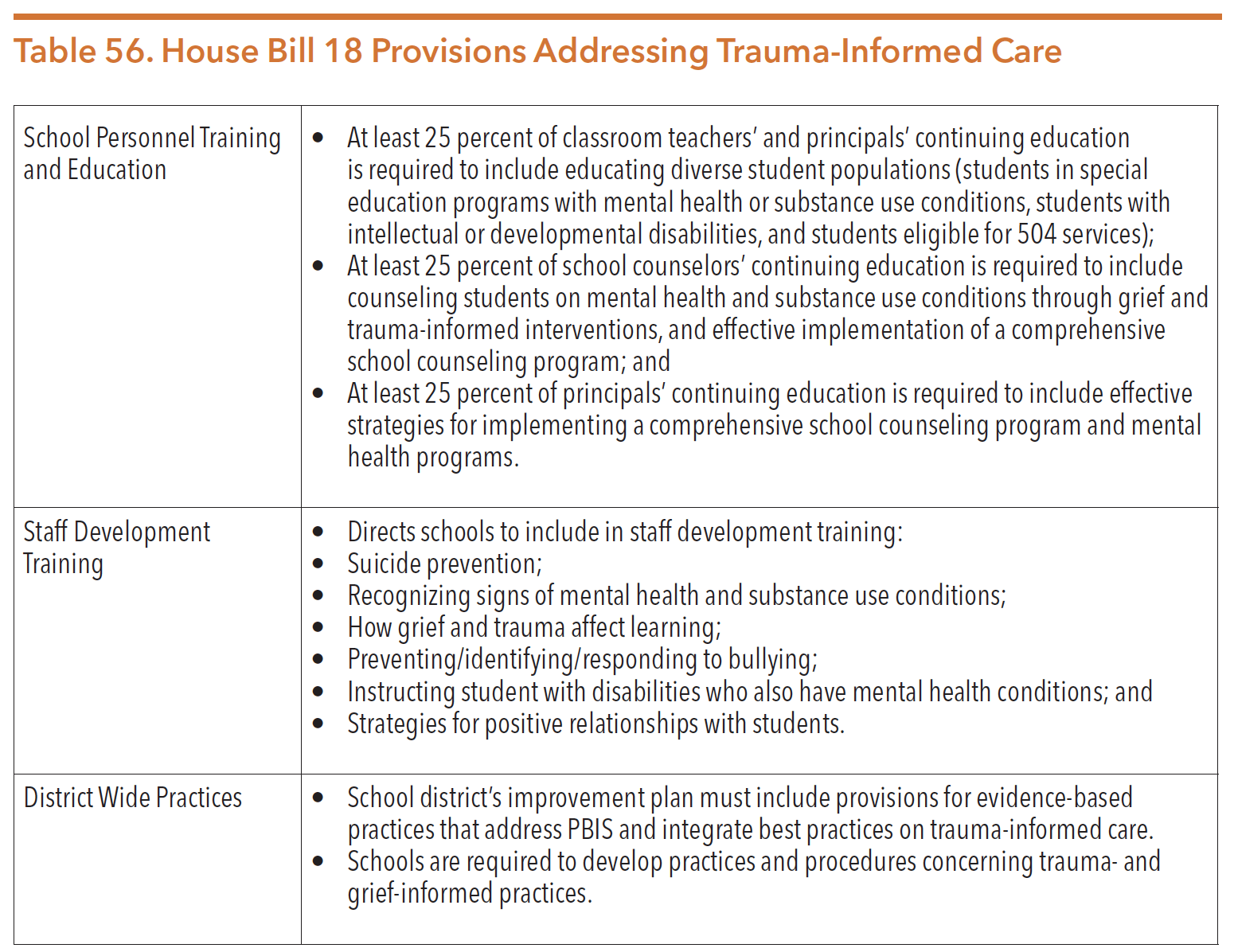
Source: The Hogg Foundation for Mental Health. (January 2020). Policy brief: School climate legislation from the 86th legislative session. Retrieved from https://hogg.utexas.edu/wp-content/uploads/2020/01/FINAL_86th-Lege_Policy-Brief_School-Climate.pdf
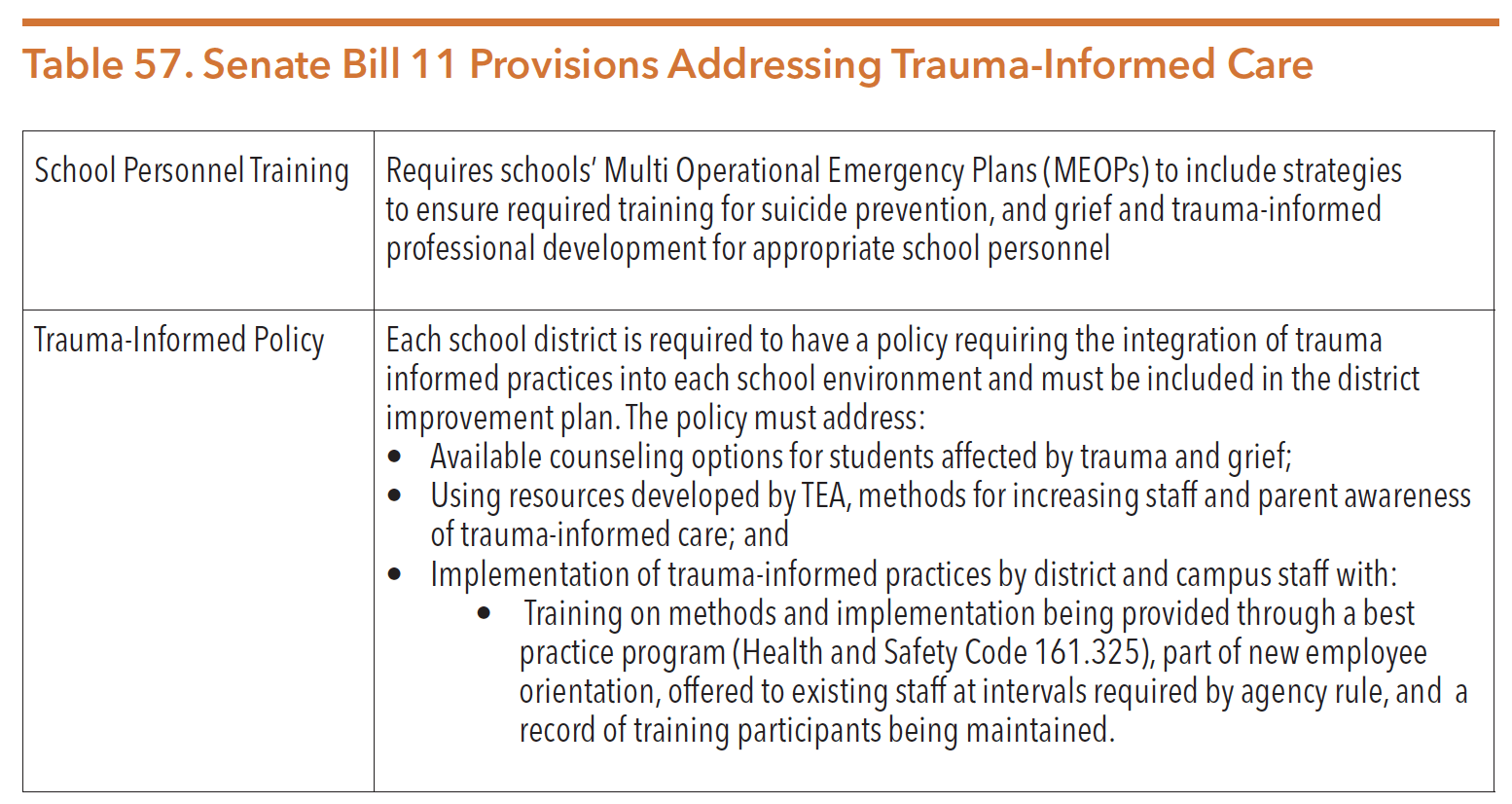
Source: The Hogg Foundation for Mental Health. (January 2020). Policy brief: School climate legislation from the 86th legislative session. Retrieved from https://hogg.utexas.edu/wp-content/uploads/2020/01/FINAL_86th-Lege_Policy-Brief_School-Climate.pdf
Mental health treatment practices (including trauma-informed care) and school-based mental health practices have yet to catch up with the reality that people with IDD can also live with serious mental health conditions including post-traumatic stress disorder (PTSD). Individuals with IDD have a greater opportunity for experiencing traumatic events than the general population. Yet behaviors associated with any resulting mental health challenges, such as PTSD, can manifest differently than in the general population and often go unrecognized. It is important that we continue to improve the accuracy of assessment tools and the effectiveness of a variety of therapies and treatments for individuals with IDD, keeping recovery at the forefront.
Too many IDD systems of care (including schools) continue to focus on controlling and managing challenging behaviors without adequate consideration of the potential for underlying mental health conditions or the impact of trauma as the cause of the behaviors. The focus of school interventions and treatment has historically been to develop behavior management plans to promote compliance or the use of medications to control the behaviors. In both cases the treatment is targeting the behavior and not the actual mental health condition, making recovery unlikely and doing little to reduce or remove barriers to learning. To better educate school personnel on mental health concerns for students with disabilities, HB 18 (Price/ Watson) allows for staff development to be inclusive of identifying and supporting students with both disabilities and a mental health condition. HB 19 (Price/Watson) requires a non-physician mental health professional employed by the LMHA to be located in the regional ESCs. The mental health professional will be responsible for facilitating optional training on a monthly basis, on the effects of grief and trauma for children with intellectual or developmental disabilities.
The Hogg Foundation for Mental Health at The University of Texas partnered with the National Child Traumatic Stress Network to develop a training curriculum and toolkit, Road to Recovery: Supporting Children with Intellectual and Developmental Disabilities Who Have Experienced Trauma. The toolkit was developed over two years with contributions from national mental health experts and IDD experts. The toolkit is designed to be a two-day train-the-trainer resource and is available free of charge at http://nctsn.org/products/children-intellectual-and-developmental-disabilities-who-have-experienced-trauma. The toolkit includes six modules:
1. Setting the stage
2. Development, IDD, and Trauma
3. Traumatic Stress Responses in Children with IDD
4. Child and Family Well-being and Resilience
5. IDD Trauma-informed Services and Treatment
6. Provider Self-Care
The toolkit includes a facilitator’s guide, videos, participant manual, case vignettes, board game/activities, slide kit, and supplemental materials. This training would be beneficial to anyone working with or supporting children with IDD. To access the toolkit requires creating an account on the website, however, the toolkit is free to anyone with an account.
Handle With Care
In 2013, Mary C. Snow West Side Elementary School in Charleston, WV piloted a program, “Handle With Care” that addressed supporting students in schools who have been present to a potentially traumatic experience at home or in the community. Handle With Care is a partnership between law enforcement and schools. The law enforcement officer at the scene of a crime/violence/abuse, identify if children are at the scene. At a minimum, the child’s name and school is sent confidentially by the officer to the child’s school before the next day with no more information given except for the three words “handle with care.” Figure 91 outlines the Handle With Care process.
“Handle With Care” is trauma-sensitive and identifies interventions that may help mitigate the negative effects of trauma on children. The program allows teachers and schools to be aware if a student has experienced trauma at home or in the community. This supports the child and the school if there are negative behaviors, so that more appropriate support, interventions, or mental health services may be offered rather than punitive punishment.
As of August 2019, over 65 cities across the US had implemented a Handle With Care program at their school districts. In January 2019, three ISDs piloted the program with San Antonio Police Department (SAPD): San Antonio ISD, East Central ISD, and Northeast ISD. During the pilot program from January 2019 to August 2019, there were approximately 80 notifications sent out from the East Patrol service area. After the success of the program, the three districts permanently implemented the program district-wide, and additional districts joined as well.
All SAPD service areas were given the training and ability to make notifications from their in-car laptops. Through the Region 20 ESC, an invitation for area schools and law enforcement agencies to be a part of the program was extended. As of April 2020, the collaboration across San Antonio encompassed all Bexar County public schools, as well as some private and charter schools, four police departments, and the San Antonio Fire Deparment. From September 2019 to March 2020, approximately 338 notifications were sent out citywide.
To continue the work during the closing of schools due to COVID-19, Handle With Care was able to continue due to schools’ innovative initiatives. For example, San Antonio ISD created a dashboard of virtual contacts with students, inclusive of Handle With Care notifications.
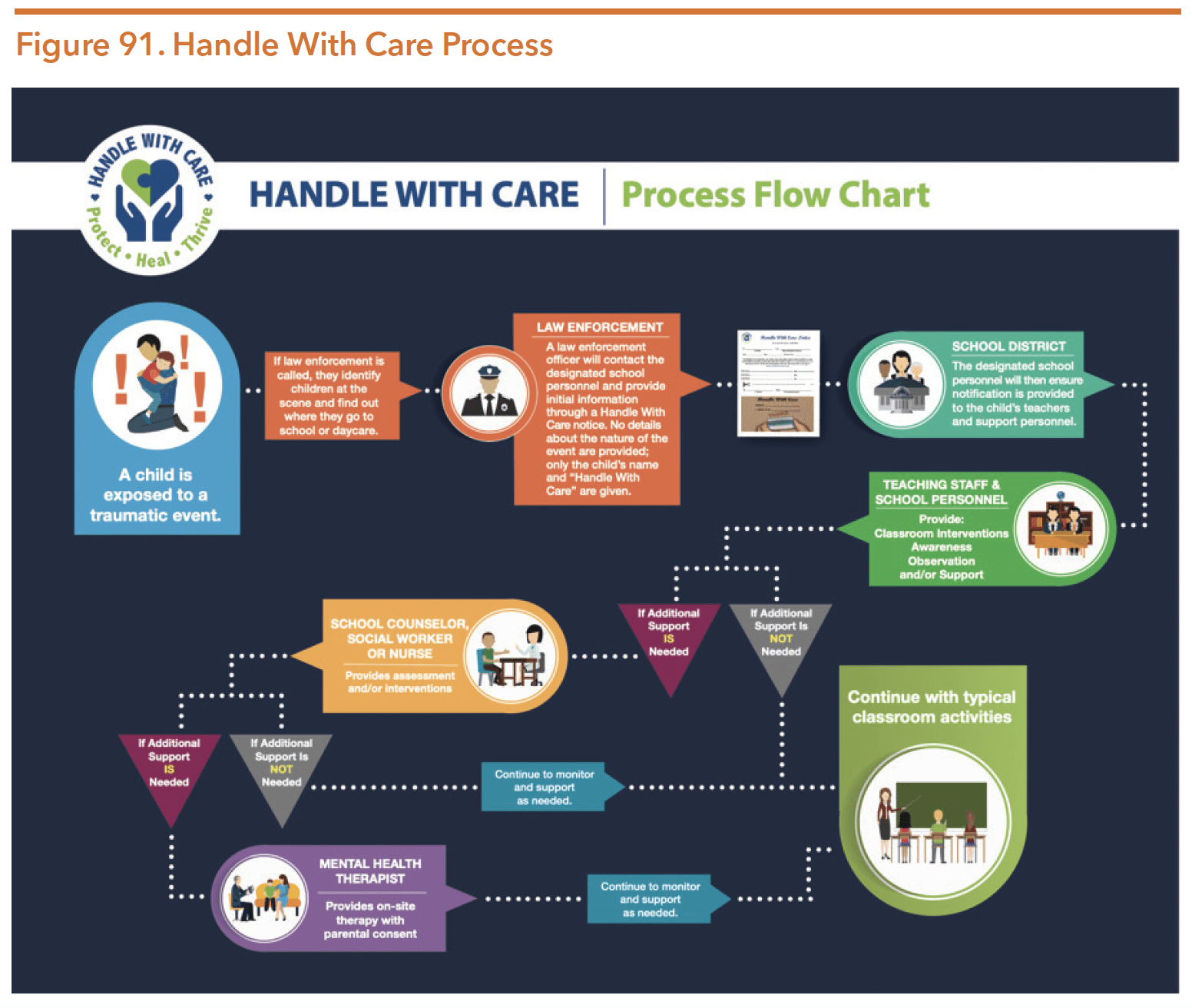
Source: Handle With Care Maryland. (n.d.) Handle with care: Process flow chart. Retrieved from https://handlewithcaremd.org/docs/Handle%20WIth%20Care%20Flow%20Chart.pdf
Restorative Justice Framework
Restorative justice is a prevention-oriented framework that views misbehavior as more than an infraction of the school’s rule by holding the student accountable in a safe, non-court setting, leading to better outcomes for students, victims, schools, and communities. In the school setting, restorative justice involves not only the misbehaving student but the person harmed and the community around them. Including the community in the process fosters a feeling of responsibility for the student, thereby strengthening and uniting a community around their young people. A restorative justice framework can be applied to the entire school setting by focusing on the impact of student misbehavior on others, and how that student and their school community can recover from the incident in a healthy way. Institute for Restorative Justice and Restorative Dialog (IRJRD) describes Restorative Discipline as “a relational approach to fostering school climate and addressing student behavior that prioritizes belonging over exclusion, social engagement over control, and meaningful accountability over punishment.”
According to a Texas Criminal Justice Coalition report, “from the requirement of taking responsibility for the wrongdoing, to making a sincere apology, to developing a plan for restitution satisfactory to the victim, to ultimately following through on that plan, professionals and students agree: far more accountability is required of a student making amends through a restorative justice model than one who is sent home via suspension or expulsion.”
Restorative justice can be implemented by using methods such as group conferencing, healing circles, check-ins, and mediated victim offender dialogue (VOD). Restorative justice helps the student consider the consequences of their actions, and also encourages empathy by using age-appropriate, feeling-centered language. For example, using restorative circles in the classroom allows students to talk openly and honestly about student misbehavior and the effects it has on the classroom or entire school. A restorative circle allows the students to use community values and group expectations to collectively address the problem and make an individualized plan for restitution. While the circles take place in classrooms, the framework is intended to be used by the entire school so that the overall school community is improved by allowing school culture to be improved as a whole rather than narrowly focusing on changing individual behaviors. Similar to PBIS and SEL, the restorative justice framework offers schools a more proactive and strengths-based framework for managing behavior and promoting academic and social-emotional growth both inside and outside of the classroom.
Costs associated with implementing restorative justice can vary between schools, but one school in San Antonio implemented a restorative justice program at an annual cost of $16,000—costs were mainly from additional staff training, consultations, and materials. The school experienced an 84 percent decrease in off-campus suspensions after switching from a “zero tolerance” policy to a restorative justice framework. Prior to implementing restorative justice to handle conflicts, this school had one of the highest rates of discipline in its district. In 2015, TEA began partnering with the Institute for Restorative Justice and Restorative Dialogue through the UT Austin School of Social Work to offer training for schools and district administrators across the state in restorative justice and restorative discipline. As of the fall of 2016, 1,400 administrators and 400 coordinators received training on restorative discipline practices. TEA plans to provide training for the remaining ten regional service centers.
SAFE AND SUPPORTIVE SCHOOL PROGRAM AND TEAM
Following the 86th legislative session, Governor Abbott signed Senate Bill 11 directing each school district to establish a safe and supportive school program (SSSP) and team among many other provisions. An SSSP encompasses six student support components seen in Figure 92. According to the Texas State School Safety Center, “a focus on prevention and intervention strategies is critical to developing an effective, comprehensive approach to promoting safe schools. Research suggests the process of threat assessment in schools as a best practice in early prevention/ mitigation and intervention toward identifying, assessing, and providing interventions to students who pose a threat of targeted violence either to themselves or others.”
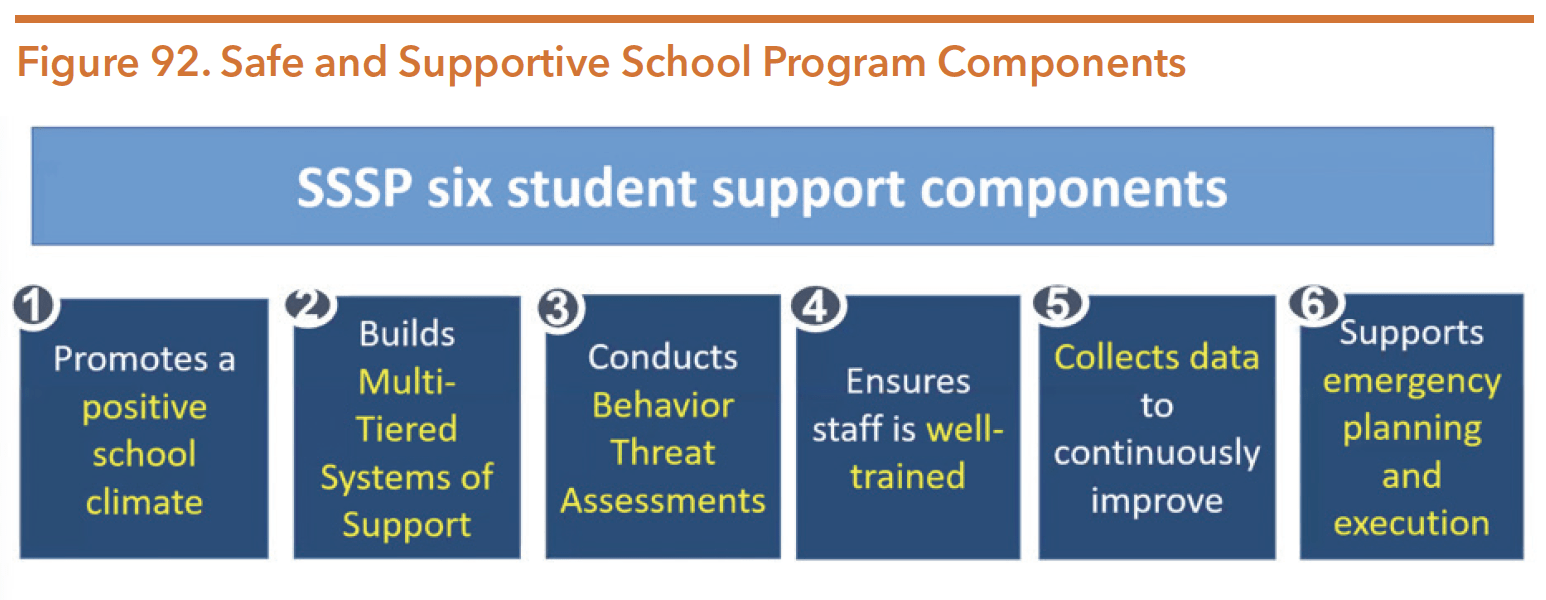
Source: Texas Education Agency. (July 16, 2020). TEA Presentation to Texas State School Safety Center Conference
SSSPs are required to include research-based best practices to provide for:
- Physical and psychological safety;
- Multiphase and multihazard approach for prevention, mitigation, preparedness, response, and recovery in a crisis situation;
- A multi-tiered support system that addresses school climate, social and emotional domains, and mental health; and
- Multidisciplinary and multiagency collaboration for risk assessment and threats in schools and provide appropriate interventions, including rules for the establishment and operation of teams.
Each Texas school district board of trustees is required to establish a safe and supportive multidisciplinary school team (“team”) to serve at one or multiple campuses in their district. The number of teams formed is at the school district’s discretion as long as a team is assigned to each campus. The teams are required to be multidisciplinary, with team members having expertise in counseling, behavior management, mental health and substance use, classroom instruction, special education, school administration, school safety and security, emergency management, and law enforcement.
Teams are responsible for conducting threat assessments which includes assessing and reporting a student who makes threats or exhibits “harmful, threatening, or violent behaviors.” These behaviors are defined as “verbal threats, threats of self-harm, bullying, cyberbullying, fighting, the use or possession of a weapon, sexual assault, sexual harassment, dating violence, stalking, or assault that could result in need for intervention/services or discipline.” The teams are then responsible for gathering and analyzing information on students to determine their level of risk and what the appropriate intervention is.
Additionally, each team will be responsible for:
- Providing guidance to students and staff on how to recognize harmful, threatening, or violent behaviors;
- Notifying the superintendent, who is required to immediately notify the student’s parent or guardian, if a serious risk of violence to self or others is determined;
- Following the district’s suicide prevention protocol if a risk of suicide is determined, and conducting a threat assessment if a threat towards others is also determined;
- Following the district’s substance use and intervention protocol if use or possession of tobacco, drugs, or alcohol is determined; and
- Developing and implementing safe and supportive school programs.
The Texas School Safety Center (TxSSC), based in San Marcos, is responsible for collaborating with TEA and schools to provide training and policies. In coordation with TEA, TxSSC is responsible for developing model policies and procedures to assist schools in establishing and training behavioral threat assessment teams, as well as rules for safe and supportive school programs. The model policies for threat assessments must include, when appropriate, procedures for:
- Referring a student to a local mental health authority or health care provider for evaluation or treatment;
- Referring a student for evaluation for special education services; and
- Anonymous reporting
When implemented with fidelity, trained professionals identify students who may exhibit concerning behaviors, and may be in need of support or services during a threat assessment. An assessment team determines what may be causing the students’ concerning behaviors. The team then develops a plan–tutoring, counseling, mentoring, or other interventions–to address the root causes. Some academic research shows that when effectively applied, threat assessments can reduce bullying and suspensions, while contributing to a general sense of safety and well-being among students.
However, without proper training, education, or oversight, other states across the country have implemented conducting threat assessments with concerning results for students with disabilities and for students of color. According to federal data, schools with higher proportions of students of color were more likely to report using threat assessments. In one New Mexico school district, 56 percent of their threat assessments were conducted on students in special education. These students made up just 18 percent of the total student population. The same school district saw 80 percent of their assessments conducted on black students who made up only 2.6 percent of the total student population.
Exclusionary Discipline in Schools
Exclusionary discipline in schools refers to practices that remove students from the classroom. Despite the lack of evidence that exclusionary discipline is an effective method of changing students’ behaviors in schools, it is often used. One in ten Texas students were suspended, expelled, or placed in an alternative education program during the 2018-2019 school year.
Furthermore, there is a disparity in removal practices due to violations of their schools’ local codes of conduct; ninety-one percent of reported reasons for exclusionary discipline actions were due to a code of conduct violation. Under state law, there are incidents that require schools to remove or expel students, but schools also have discretionary authority for removal of students. In those instances, no other data is currently collected to show why students are being disciplined or what is needed to support teachers in the classroom. Classroom removals consist of removals to in-school suspension (ISS), out-of-school suspension (OSS), JJAEP, and DAEP.
Table 58 illustrates the classroom removals for the 2018-2019 school year, showing the number of removals due to a violation of schools’ local codes of conduct in comparison to the next four most common reported reasons:
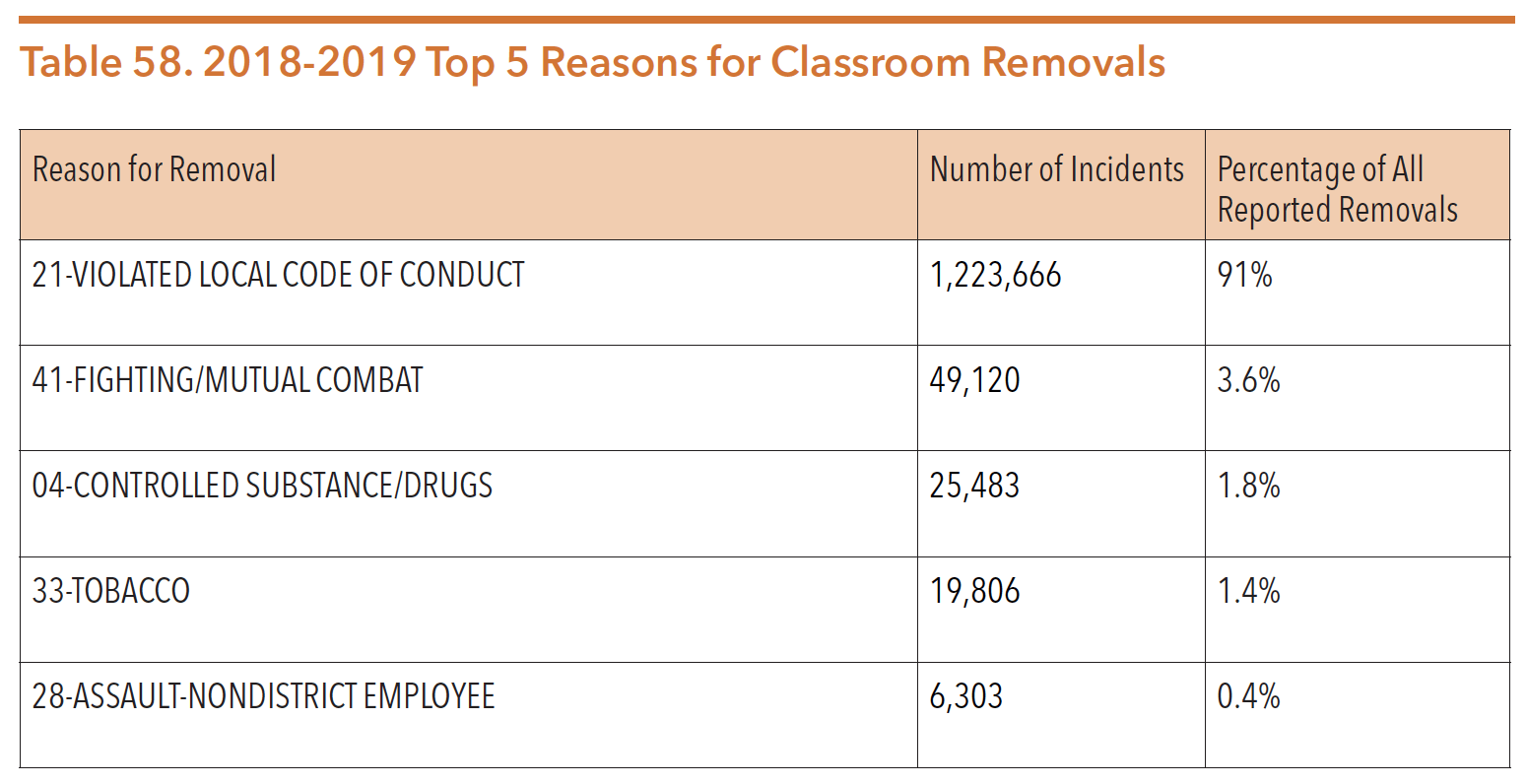
Source: Texas Education Agency. (2019, September 19). State Level Annual Discipline Summary: PEIMS Discipline Data for 2018-2019. Retrieved December 10, 2019, from https://rptsvr1.tea.texas.gov/cgi/sas/broker_service=marykay&_program=adhoc.download_static_summary.sas&district=&agg_level=
STATE&referrer=Download_State_Summaries.html&test_flag=&_debug=0&school_yr=19&report_type=html&Download_State_Summary=Next
EFFECTS OF REMOVALS
Removal from the classroom excludes students from common, daily experiences that are conducive to normal childhood and student development. Research shows that exclusionary discipline increases the likelihood of lowered academic performance, dropping out, antisocial behavior, and future contact with the justice system.158,159 Data shows that the impact of 9th grade suspensions is significantly related to high school and post-secondary outcomes. Additionally, each subsequent suspension decreases a student’s odds of graduating high school by 20 percent, and their odds of enrolling in post-secondary schooling by 12 percent.
Further, exclusionary discipline at a young age has harmful, long-term effects academically, emotionally, and socially. Early expulsion or suspension predicts expulsion or suspension in later school grades. Young children who are expelled or suspended are as much as 10 times more likely to drop out of high school, experience academic failure and grade retention, hold negative school attitudes, and face incarceration than those who are not.
HB 674 (85th Johnson/Garcia) changed the law to prohibit OSS to students below grade 3. However, students of all ages can still be given ISS and children over the age of six can still be placed in DAEPs. To better support students who may be in need of additional supports, or have experienced more adverse experiences, the Texas legislature passed House Bill 811 (White/West) during the 86th session. The bill requires schools to consider students’ status in the conservatorship of DFPS or who are homeless before suspension, removal to DAEP, expulsion, or placement in JJAEP.
DISPARITIES
Students of color and those with disabilities experience more disproportionate rates of removals from their classrooms than white students and those without disabilities illustrated in Table 59. Youth in foster care are another group removed more often than their peers. From 2017-2018, children in foster care from pre-kindergarten to second grade in Texas were three times more likely than their peers to be suspended.
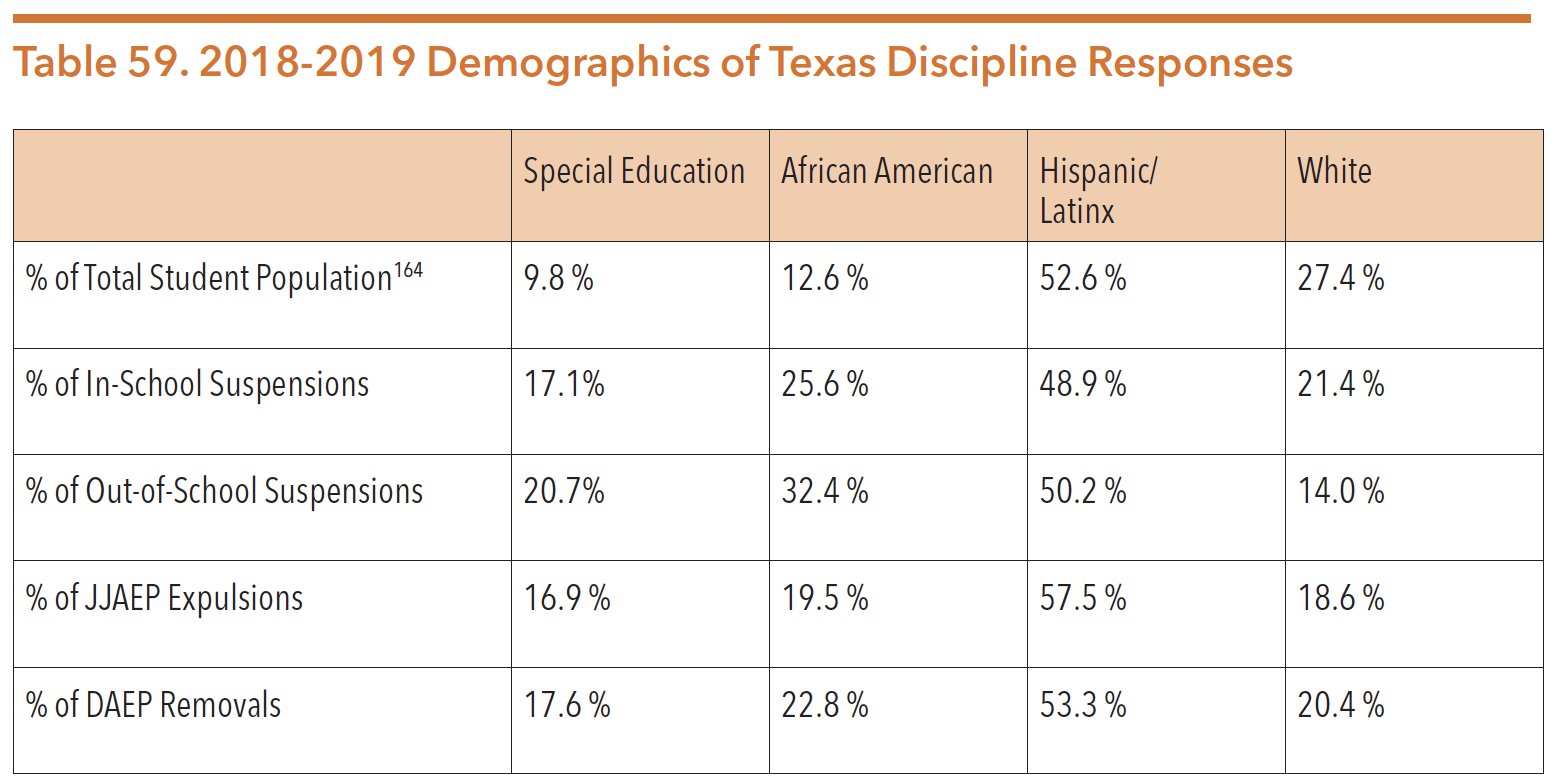
Source: Texas Education Agency. (2019, September 19). State level annual discipline summary: PEIMS discipline data for 2018-2019. Retrieved December 10, 2019, from https://rptsvr1.tea.texas.gov/cgi/sas/broker_service=marykay&_program=adhoc.download_static_summary.sas&district=&agg_level=
STATE&referrer=Download_State_Summaries.html&test_flag=&_debug=0&school_yr=19&report_type=html&Download_State_Summary=Next
Highlighted by COVID-19, the health disparities and inequities for people of color is glaring. These disparities and inequities have long been identified in schools. Research shows that while students of color do not “misbehave” more frequently or more seriously, they are disproportionately disciplined and arrested at school. This may suggest that students of color with mental health concerns are most affected by these practices. In exploring ways to improve mental health and wellness in schools, addressing systemic inequalities and their impact on these children must be included.
IN-SCHOOL SUSPENSIONS AND OUT-OF-SCHOOL SUSPENSIONS
A disruptive student can be removed from the regular classroom and assigned one or more days to a separate in-school suspension classroom to complete their class assignments, or they may be required to remain off campus for a specified period of time. According to the Texas Education Code, the principal or other appropriate school administrator may also suspend a student for engaging in conduct identified as prohibited in the school’s code of conduct. In addition to removing children from their regular classroom and normal interactions with their peers, ISS and OSS can also lead to significant cost increases for schools and families. ISS and OSS place a strain on families who need to make transportation and/or childcare arrangements, and schools lose roughly $45 in funding from the state for each day a child is absent. During the 86th legislative session, Texas took steps to limit youth experiencing homelessness from being given out-of-school suspensions due to their lack of safe, stable housing. HB 692 (White/Alvarado) prohibits the out-of-school suspension of students experiencing homelessness unless the student engages in certain behaviors defined in the Education Code, including violent offenses, weapons, and drug use.
In the 2015-16 school year, Texas schools issued over 63,000 out of school suspensions for children in pre-k through 5th grade. Further, over 1,800 of these suspensions were given to pre-kindergarten students and over 24,000 of those suspensions were students in grades K-2. To address the removals of these young children, in 2017 the 85th Legislature passed HB 674 (Johnson/Garcia) to prohibit discretionary out-of-school suspensions for students below third grade. The bill also allowed public schools to implement a positive behavior program with age-appropriate alternatives to out-of-school suspensions. However, districts had significantly reduced out-of-school suspension of students in the earliest grades during the 2017-2018 school year, simultaneously some districts continued to issue out-of-school suspensions to these students. Additionally, the high number of in-school suspensions remained virtually unchanged during the same time frame. School districts issued a total of 62,557 in-school suspensions in pre-k through second grade, compared to 64,773 in-school suspensions issued in 2015-16.
REMOVALS TO DISCIPLINARY ALTERNATIVE EDUCATION PROGRAMS
Every school district in Texas is required to provide a Disciplinary Alternative Education Program (DAEP). Districts may operate their own DAEP or can join together to support a cooperative program. A DAEP in smaller rural districts may be a separate classroom on the school campus, but DAEPs are more frequently housed at a separate campus. According to statute, the central academic mission of DAEPs “is to enable students to perform at grade level.” Any DAEP that serves a student with an IEP must provide the services outlined in that plan. The Breaking Schools’ Rules study found that “because there has been little monitoring and oversight of DAEPs, the quality of the programming and instruction varies among districts, with some students in DAEPs poorly served by under-resourced programs.” As result of the passage of SB 2432 (Taylor/Sanford) during the 86th legislative session, Texas added the offense of harassment as a mandatory reason for a student ro be removed to a DAEP.
Certain infractions require mandatory removal to a DAEP according to the Texas Education Code:
- Committing a felony or engaging in conduct punishable as a felony
- Assaulting another student or school employee
- Selling, giving, possessing, or being under the influence of a dangerous drug or alcohol
- Committing an offense that involves volatile chemicals, public lewdness, or retaliation against a school employee
- Making a terroristic threat or a false alarm/report
- Harrassing an employee of the school district
Texas schools have wide discretion to send students to a DAEP for other offenses listed in their student code of conduct. Depending on the school district, these offenses can range from “fighting and gang activity to disrupting class, using profanity, playing a prank such as throwing a tennis ball in the hallway and narrowly missing another student, misusing a school parking decal, inadvertently bringing a prescription or over-the-counter drug to school, or doodling in class when the drawing contains a weapon.” In the 2018-19 school year, more than half of removals to DAEPs were discretionary (52 percent). A study conducted by IDRA looked at results of DAEP policies in 1999 and 2009. Both studies found that four out of five students sent to DAEPs were sent for non-serious offenses, with some of those referrals for behaviors as minor as talking back to a teacher or chewing gum.
Students in DAEP facilities lose time in their regular instructional classroom and face an increased likelihood of negative effects including in-grade retention, school disengagement, and contact with the justice system. A comprehensive study of nearly 1 million Texas students found that 15 percent of students were assigned to a DAEP at least once between seventh and 12th grades. On average, those students lost 27 days of regular classroom instruction. Additionally, 31 percent of students who received one or more disciplinary actions (including suspensions and other expulsions) were held back a grade level at least once, compared to about 5 percent of their peers who received no action.
EXPULSIONS TO JUVENILE JUSTICE ALTERNATIVE EDUCATION PROGRAMS
When children in Texas are expelled from school, they are sent to either Juvenile Justice Alternative Education Programs (JJAEPs) or expelled without placement into a program (i.e., “expelled to the streets”), and a small number of expelled students are sent to DAEPs. JJAEPs were created in 1995 to provide ongoing educational services for students who have been expelled. Every county in Texas with a population of more than 125,000 residents at the time of the 2000 census must have a JJAEP. Counties that meet the 125,000 population requirement after the year 2000 are able to, but do not have to open a JJAEP.
JJAEPs are operated by juvenile boards with oversight provided by TJJD so when a student is expelled to a JJAEP, that referral is considered involvement in the juvenile justice system.186 Legislative intent in creating JJAEPs was “to provide continuing educational opportunities for students expelled from school for the most serious offenses.” The primary goals of JJAEPs are to “reduce delinquency, increase offender accountability and rehabilitate offenders through a comprehensive, coordinated community-based juvenile probation system.” Students younger than 10 cannot be sent to a JJAEP; instead, they are sent to DAEPs for engaging in conduct that would result in expulsion to a JJAEP for children over 10 years old. School districts without a JJAEP may send expelled students to DAEPs or opt to expel them without placement, also known as expulsion “to the street” because students serve the length of their expulsion unsupervised and outside of a school setting. After the 2010-11 school year, JJAEPs entries dropped, largely in part due to the removal of “persistent misbehavior” as an expulsion reason from the Texas Education Code, Chapter 37. However, the 2018-2019 school year saw the first increase since then, partly due to the increase of mandatory expulsions for drug offenses.
During the 2018-19 school year, JJAEPs served 30 counties with 282 school districts in Texas. Texas school districts placed students into JJAEPs on 3,210 separate actions in 2018-19, an increase by 271 from the 2017-2018 school year.
A report from TJJD cited 482 entries into JJAEPs for students receiving special education services in 2018-19:
- 200 students had a primary diagnosis of a learning disability;
- 128 students had a primary diagnosis of serious emotional disturbance;
- 16 students had a primary diagnosis of an intellectual disability;
- 98 students had at least one “other health impairment.” This included attention deficit, with or without hyperactivity, or a medical issue that may interfere with academic progress; and
- 40 students had a primary diagnosis of “other”, which includes unknown, other, autism, developmental delay, deaf-blindness, speech/language impairment, or hearing impairment.
While discretionary removals to JJAEPs were slightly lower than mandatory removals for the general student population, students with disabilities were more likely to be removed to JAAEPs for discretionary reasons than mandatory. During the 2018-2019 school year, students in special education accounted for 11 percent of the mandatory removals to JJAEPs, compared to 20 percent of the discretionary removals.
Some school districts use JJAEPs at a higher rate than others, and the size of the school district does not necessarily correlate with the number of student expulsions. Similar to removal to DAEPs, students can be expelled to JJAEPs for mandatory or discretionary reasons. Mandatory expulsions occur when a student uses, exhibits, or possesses a weapon or engages in other serious behaviors. Discretionary expulsions vary widely from serious offenses that occur within 300 feet from the school, to assault on a school employee or serious misbehavior in a DAEP. In 2018-19, 34 percent of expulsions to JJAEPs were discretionary while 55 percent were mandatory and 11 percent were non-expelled.
The vast majority (85 percent) of mandatory referrals to JJAEPs in 2018-19 were for felony drug or weapons offenses, while reasons for discretionary referrals were more varied, suggesting wide variation in discretionary disciplinary policies betweenschools. Discretionary expulsions for misbehavior and misdemeanor drug charges represent 64 percent of all discretionary expulsions in 2018-19, down 1 percent from 2017-2018. The large number of student expulsions due to drug use provides opportunities for schools to provide substance use services and support, rather than costly, punitive removals from the classroom. There are no statewide standards that set minimum or maximum amounts of time for expulsions, so there is wide variation across school districts regarding how much time students spend in a JJAEP. However, TJJD publishes data that provides some understanding of how long students spend in JJAEPs at the macro level. In 2018-19, the average length of stay for all students who finished JJAEP was 77 days.
Cost of Operations
JJAEPs are funded differently than public schools in Texas. While public schools receive funds through county tax revenues, state general appropriation funds administered by TEA, and federal funds, JJAEPs receive funding from local school district revenues, county commissioners’ courts, and state appropriations through TEA via Texas Juvenile Justice Department (TJJD). TJJD provides approximately 25 percent of the total JJAEP funding (i.e., $86 per mandatory student attendance day); the remaining 75 percent is provided through the local juvenile boards and the local school districts.
Total expenditures for all JJAEPs during the 2018-2019 school year increased by approximately $1.639 million compared to the 2016-2017 school year. The cost per school day (based on 180 student attendance days and 10 staff in-service days) varied greatly from $1,376.86 to $16,804.65. Four programs had a per school day cost over $10,000 per school day: Fort Bend, Harris, Montgomery and Tarrant, and five counties had a per school day cost between $5,001 and $10,000 per school day: Bexar, Collin, Dallas, Denton and Williamson. Sixteen of the counties however had a per school day cost of less than $5,000. The cost of JJAEPs vary based on an array of factors including: program size, program design, facilities, attendance, and services provided.
Many experts agree that there is a school-to-prison pipeline for a majority of the students who are removed from the classroom using exclusionary discipline practices. Child advocates and school districts in Texas are increasingly utilizing methods of disciplining children without suspending or expelling them to programs like JJAEPs, but it is still important to understand the short and long-term effects experienced by children coming out of JJAEPs. Although the goal of JJAEPs is to rehabilitate and integrate students back into a mainstream school environment, alternative education programs have been linked to increased levels of delinquency and adversity. For example, students who have been sent to ISS, OSS, or a DAEP are more likely to be expelled and sent to a JJAEP than those who are not referred to one of these exclusionary discipline settings. Furthermore, students sent to a DAEP or a JJAEP are more likely to drop out of school and enter the adult criminal justice system. One study conducted by Texas Appleseed concluded that “placing students in JJAEPs for ‘serious or persistent misbehavior’ not only fails to correct behaviors, but leads to increased risk for future involvement in the juvenile justice system.” Research shows that compared to non-disciplined students, 23 percent of students who received school disciplinary actions had future contract with juvenile justice system. While these correlations do not imply a direct causation of exclusionary discipline resulting in future incarceration, these findings call into question the effectiveness of ISS, OSS, DAEPs, and JJAEPs in successfully rehabilitating students on a long-term basis and integrating them back into a mainstream educational setting.
CORPORAL PUNISHMENT, RESTRAINTS, AND SECLUSION IN SCHOOLS
In Texas, each school district is allowed to determine whether corporal punishment is permitted on their campus. After Mississippi, Texas ranks second highest in paddlings across the country. Educators may use corporal punishment when the board of trustees has adopted a policy allowing its use, unless the student’s parent, guardian, or other person having lawful control over the student, opts out of the practice and provides a written, signed statement prohibiting the use of it. Nationwide and in Texas, students with disabilities and Black students are disproportionately the targets of corporal punishment. Corporal punishment can cause serious injury, psychological harm, trauma, and academic disengagement; it is not an evidence-based practice and has been banned by the majority of states (31) in the U.S. and in many school districts.
Child advocates have a serious concern with the ongoing use of restraints and seclusion as a form of discipline in schools. The Office of Civil Rights within the U.S. Department of Education has conducted a survey since 1968 that “collects data on leading civil rights indicators related to access and barriers to educational opportunity at the early childhood through grade 12 levels,” known as The Civil Rights Data Collection (CRDC). Every two years, schools are required to submit various information for the collection. The CRDC collects data from public LEAs and schools, including juvenile justice facilities, charter schools, alternative schools, and schools serving only students with disabilities. The U.S. Department of Education began requiring data on the use of restraints and seclusions in the 2009-10 school year.
According to the most recent data collected from the 2015-2016 school year, Table 60 illustrates the number of restraints and seclusions used on students with and without disabilities. While only making up 12 percent of the total student population, students with disabilities were disproportionately subjected to restraints and seclusions.
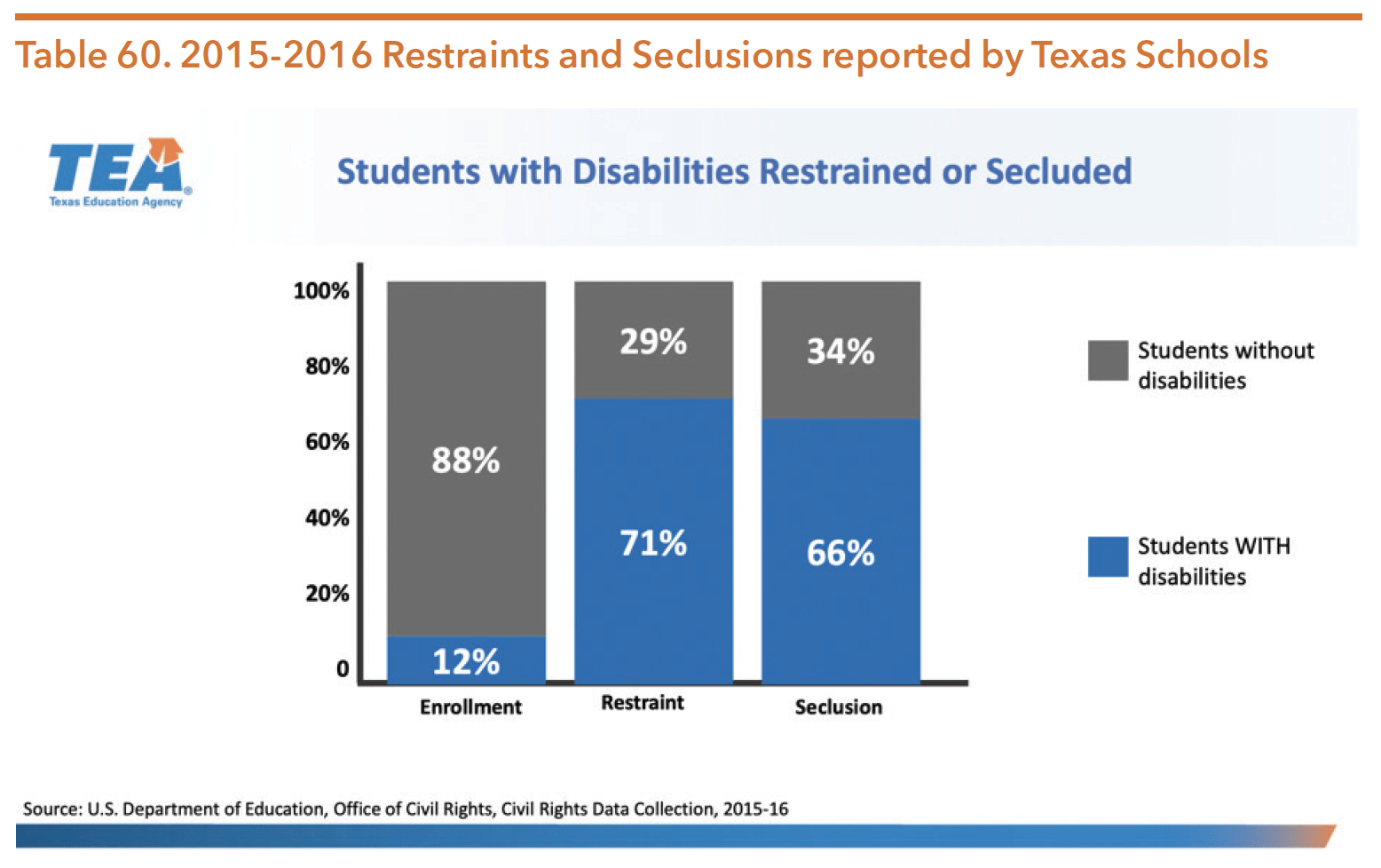
Source: Texas Education Agency. (2020). Behavior: Section 504 & The Americans with Disabilities Act. Retrieved from https://tea.texas.gov/sites/default/files/Behavior%20-%20504%20webinar_accessible.pdf
During the 86th legislative session, Texas passed HB 3630 (Meyer/Lucio) in order to ensure schools were not using “aversive techniques,” defined as a technique or intervention that is intended to reduce the likelihood of a behavior reoccurring by intentionally inflicting on a student significant physical or emotional discomfort or pain. Additionally, the 86th Texas Legislature passed SB 1707 (Lucio/Allen) in order to better support schools who employ school resource officers (SROs) by clarifiying that school police officers should not be involved in the routine discipline of young people on their school campuses. Under this law, school districts write out the roles and responsibilities of SROs, to be placed in student codes of conduct, district improvement plans, and the memorandum of understanding between the school district and the local law enforcement agency.
TEA requires each school to have a team of school staff trained in restraints appropriate for youth, with certain school staff positions required to be a part of the team. The participation of SROs is not mandated in current law. Historically, SROs who are working to protect public school environments have not had training in trauma-informed care, age-appropriate discipline for youth with cognitive or emotional disabilities, appropriate techniques for de-escalation specific to child-centered settings, or restraint training. However, during the 84th legislative session, HB 2684 (Giddings/Whitmire) improved mandated training for SROs to include de-escalation techniques, positive behavioral interventions, and the behavioral health needs of children with disabilities and mental health needs if they served in a district with more than 30,000 students. During the 86th legislative session, SB 11 (Taylor/Bonnen) eradicated the student population limit and required all SROs to complete specialty training (regardless of district size). In addition, current SROs who were previously exempt were given a timeline to complete the necessary training.
There are districts implementing less aversive ways to address student discipline needs. One example is crisis intervention teams for children and youth designed to divert individuals with mental health needs to appropriate behavioral health services and supports instead of referral to the juvenile justice system. Building community partnerships to support youth’s ability to access services and supports is the foundation of a successful CIT program. As an example, Bexar County created the Children’s Crisis Intervention Training for use in schools in the Greater San Antonio area. The 40-hour training is approved by the Texas Commission on Law Enforcement Officer Standards and provides CEUs for SROs who have not previously received any CIT training. Bexar County’s CCIT includes education on:
- Officer tactics and safety in school campus environments
- Active listening and de-escalation techniques
- Mental illness, learning and developmental disabilities, and substance abuse in children and youth
- Psychotropic medications
- Family perspective and community resources
- Legal issues relating to school environment and minors and emergency detention
- Role-play scenarios that allow officers to gain practical experience in active listening and de-escalation techniques specific to students experiencing a crisis
EFFORTS TO REDUCE BULLYING
Texas legislators and a wide range of advocacy organizations acknowledge and prioritize action to mitigate the negative impact of bullying in schools and through the Internet. In one study of 250 middle school students, 90 percent of the students who were bullied experienced negative side effects as a result of the bullying. Examples of these side effects include anxiety, low grades, and social rejection. The Texas Education Code requires each school district to have an anti-bullying policy that ensures educators enforce appropriate measures and methods to prevent bullying. TEA has developed a webpage to provide administrators, educators, parents, and students with resources about bullying: http://tea.texas.gov/Texas_Schools/Safe_and_Healthy_Schools/Coordinated_School_Health/Coordinated_School_Health_-_Bullying_and_Cyber-bullying/.
Research indicates that bullies and victims share many of the same risk factors and could benefit from interventions to improve their problem-solving skills, social interactions and interpersonal communication. Interventions to address bullying show moderate success; the most effective are intensive programs that avoid peer-based approaches and include parent meetings, firm discipline, and better playground supervision. Schoolwide efforts like PBIS and SEL also have the potential to reduce bullying by creating an environment of open communication and respect across the school campus.
In the 85th Legislative Session, SB 179 (Menendez/Minjarez), known as David’s Law, was passed in an effort to address cyberbullying in public schools. The bill defines bullying and cyberbullying, requires school boards to establish procedures for reporting on bullying, and enables districts to develop policies to help prevent and mediate bullying. Building on this momentum, SB 11 (86th, Taylor/Bonnen) required the State Board of Education to develop rules requiring school districts to incorporate instruction on digital citizenship and legal consequences of cyberbullying. Additionally, bullying and cyberbullying were codified as possible behaviors to initiate engagement with the threat assessment team. Further, HB 18 (86th, Price/Watson) required staff development training in schools to include preventing, identifying and responding to bullying.
CommunitiesInSchoolsandDropoutPrevention
Communities in Schools (CIS) is a national dropout prevention program funded through state and local support. CIS provides individualized case management, counseling, and other mental health-related services. In the 2018-19 school year, CIS provided case management services for 88,644 students through 28 local CIS programs operating in 139 school districts on 967 campuses across Texas. Of the students receiving CIS case management services in grades 7 through 12, 99 percent stayed in school during the 2018-19 school year, and 96 percent of CIS participants were promoted to the next grade. These students also saw improved academics, graduation rates, attendance, and behavior.
State funding cuts to the CIS program in 2013 significantly impacted service delivery, but the roughly $5 million that was cut from the CIS budget has largely been restored in the years since, increasing annual state appropriations for CIS to an estimated $15,521,815 from 2014 until 2019. During the 86th legislative session, the Legislature recognized the value of these supports and funded an increase of $15 million, appropriating $65,538,664 in general revenue for the 2020-21 biennium. In the 2018-2019 school year, these 28 programs case managed 88,644 students on 967 campuses in 139 school districts. TEA is requesting to to continue this funding into the 2022-23 biennium, and estimates the additionally funding will help them serve over 115,000 students a year. Additionally, CIS receives approximately $4,842,342 in TANF federal funding.
To learn more about CIS services in Texas and see a list of all CIS providers in the state, visit https://tea.texas.gov/texas-schools/support-for-at-risk-schools-and-students/communities-in-schools.